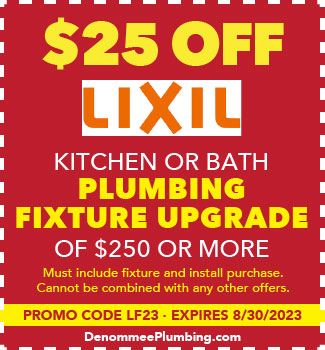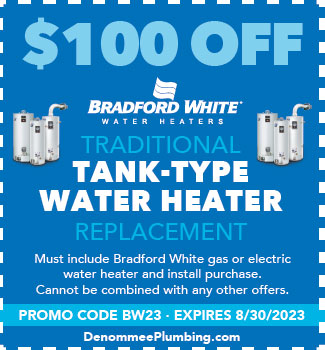-
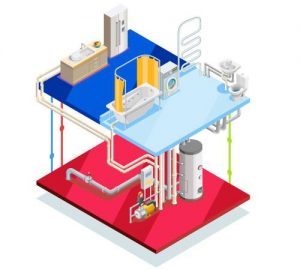 Plumbing is in our name for good reason. Denommee Plumbing, Heating & Cooling is your go-to expert source for all your plumbing needs. We provide top-to-bottom installation, service and repair for residential plumbing. Look to us for new construction, bath and kitchen remodeling, and much more, including but, not limited to:
Plumbing is in our name for good reason. Denommee Plumbing, Heating & Cooling is your go-to expert source for all your plumbing needs. We provide top-to-bottom installation, service and repair for residential plumbing. Look to us for new construction, bath and kitchen remodeling, and much more, including but, not limited to:Service plumbing: faucets, fixtures, pipe repair, leak repair
Water Heaters: water heater sales, water heater replacement service, installation and sales of Bradford White tank water heaters, Rinnai tankless water heaters, electric water heaters, hybrid electric water heaters, heat pump water heaters, indirect and power vented water heaters
Gas Piping: New installations and modifications of existing systems of natural gas and liquified propane gas systems
Sump Pumps: Service and installation of basement dewatering systems
Water Piping: Water service installation, upgrades and irrigation systems
Sewer Piping: Replacement of old faulty cast iron. Alterations and installations of new piping above and below ground
You can conveniently request plumbing service and book appointments right here on our website.
But, just what is plumbing you ask? Well, we are big believers in education—the more you know the further you will go— for our technicians and for our customers alike. Understanding the basics can help you to make informed decisions about your own plumbing system and be better equipped to provide us with correct information to help us get you the exact help you need when you need it. To that end, we offer this quick primer on plumbing systems. In a nutshell, plumbing is your home’s circulatory system. It consists of two primary portions: supply, providing fresh water and waste, moving drainage out.
Plumbers install a supply line, or pipe, from the street or well through the foundation wall or the slab. They then run the lines that supply water to the home and to rooms where sinks, bathtubs, showers and other fixtures are to be installed.
The drain waste vent pipe is part of a home’s plumbing system that is specifically used to carry waste water down and away from the home, and allows sewer gases to be pushed out through the roof. Drain waste vent pipes are typically plastic.
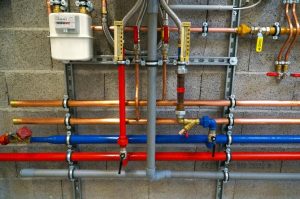 Copper pipe is the traditional material most often used for water supply lines, although plastic piping materials including PEX are available and code approved. The system illustration shows the path of the water to the fixtures, as well as the path for waste water from the fixtures through the drain waste vent pipes (DWV), and away from the home.
Copper pipe is the traditional material most often used for water supply lines, although plastic piping materials including PEX are available and code approved. The system illustration shows the path of the water to the fixtures, as well as the path for waste water from the fixtures through the drain waste vent pipes (DWV), and away from the home. Plumbing systems are required by code to have features that keep the home’s occupants safe. Some of these elements include:
- Anti-scald control at each shower fixture to prevent water from getting too hot.
- Traps at each fixture to prevent toxic sewer gases from entering the home. A trap is a curved section of plumbing pipe that seals the pipe to prevent sewer gas from getting into the home. Additionally traps prevent unwanted items, like hair or debris, or items such as jewelry that fall down the drain from becoming stuck in the waste system.
- Drain waste vent pipes that release harmful sewer gases through the roof.
A plumbing inspector checks the installation when the pipes are being put in, and again when the home is finished — right before closing — to ensure all codes are followed and the plumbing is safe for the occupants.
Plumbers also install gas lines in the home often in conjunction with the plumbing. Gas supply lines can be made of black iron or flexible stainless steel or flexible copper pipe. Gas is distributed through the home by a single pipeline that has other pipes branching from it, or by a manifold, which is a pipe with several outlets for supplying multiple pipes.
 The plumbing system also includes the water heater. The most common types of water heaters are gas, electric, oil or propane. If you have a gas water heater, direct vented is preferred. If that’s not an option, the second choice is power vented. Direct vented and power assisted are terms that describe how gases generated by the water heater are released from your home, which is critical for you and your family’s health. Direct and power vented gas hot water heaters are less susceptible to combustion gases flowing back into the home because they force combustion gases out of the house.
The plumbing system also includes the water heater. The most common types of water heaters are gas, electric, oil or propane. If you have a gas water heater, direct vented is preferred. If that’s not an option, the second choice is power vented. Direct vented and power assisted are terms that describe how gases generated by the water heater are released from your home, which is critical for you and your family’s health. Direct and power vented gas hot water heaters are less susceptible to combustion gases flowing back into the home because they force combustion gases out of the house.The efficiency of a water heater is measured by its Energy Factor (EF). Hot water tanks with an EF greater than 0.56 for gas-fired units and 0.88 for electric units are recommended. For a higher initial cost, you may be able to choose a heat pump water heater or instantaneous water heater. These are more efficient water heaters. You should discuss the features and benefits of both with your builder. You can conveniently request hot water heater service and book appointments right here on our website.
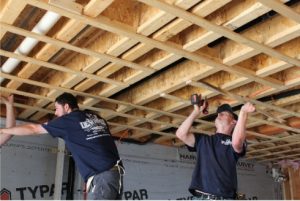 Denommee Plumbing, Heating & Cooling are fully licensed, bonded and insured plumbers. We are experts in all phases of plumbing system installation service and repair. Every one of our technicians have passed a full criminal background check and are actively involved in an array of continuing education programs to ensure we deliver our customers the most knowledgeable and capable plumbing service available.
Denommee Plumbing, Heating & Cooling are fully licensed, bonded and insured plumbers. We are experts in all phases of plumbing system installation service and repair. Every one of our technicians have passed a full criminal background check and are actively involved in an array of continuing education programs to ensure we deliver our customers the most knowledgeable and capable plumbing service available.  Call Denommee Plumbing, Heating & Cooling for all your plumbing needs. We provide top-to-bottom installation, service and repair for residential plumbing including bath and kitchen remodeling, new construction projects, and much more more.
Call Denommee Plumbing, Heating & Cooling for all your plumbing needs. We provide top-to-bottom installation, service and repair for residential plumbing including bath and kitchen remodeling, new construction projects, and much more more.
Denommee Plumbing, Heating & Cooling is your resource for all manner of bathroom plumbing and bath remodeling needs. We are here to help you from start to finish whether your bathroom plumbing project involves new construction, remodeling, a light refresh or bath repair, we have licensed experts and technicians ready to make it happen.
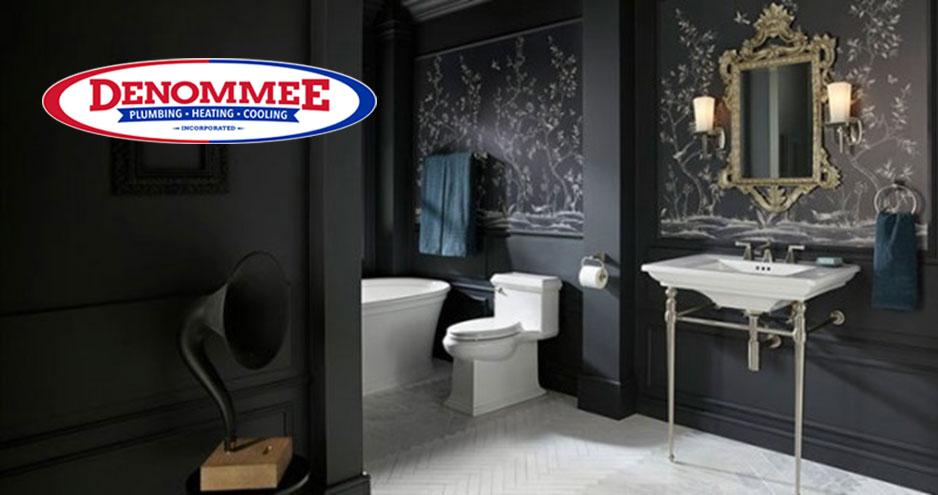
Our service is legendary, and we have decades of experience in getting bathroom plumbing done clean, fast, professionally and at the right price. Getting started is easy, read on below for helpful info, and then call Denommee Plumbing, Heating & Cooling at 978-649-8886 for a free in-home consultation or simply request bathroom plumbing service and book appointments right here on our website.
Bathroom Remodeling Guide
A stunning, elegantly re-designed bathroom shouldn’t lose its luster over time. Use this helpful guide to create a space that’s equal parts classic and enduring so you can be sure to get the most out of your remodel for years to come.
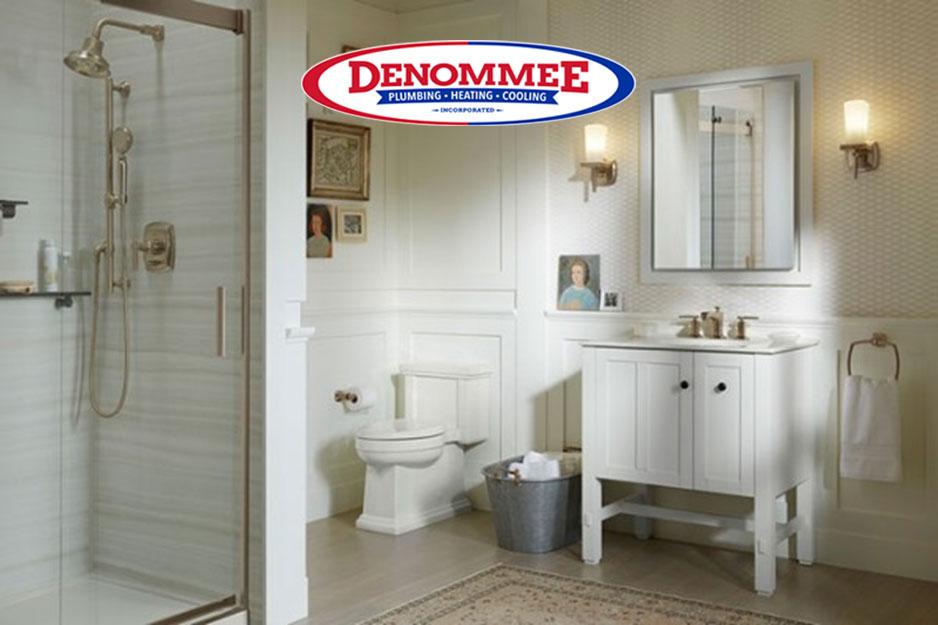
Where to Start Before You Start.
Having a basic knowledge of the history of design is important as you start your remodel journey and establish a clear design plan to build off. Using this style cheat sheet will help you answer the following questions:
- How is interior design different than interior decoration?
- Can contemporary design still be modern?
- Are traditional ideas also old fashioned?
The more you know, the easier it will be to make design choices that keep your personal style front and center.
Why Design Around Timelessness?
No matter how you choose to design your space, you’re sure to be on-trend if you keep timelessness as your North Star. From vintage art glass accessories to flourishing ceiling medallions and every piece in between, no detail is too small to evoke the fulfillment of creating a bathroom that becomes an icon in your home.
Incorporate Classic Components.
Using neutral color fixtures and faucets like those from the KOHLER Memoirs Collection are sure to blend with many styles down the road. Once the core of your bathroom is timeless, you’re free to experiment with accents like bold wallpaper that can be redone more often and more easily. A bathroom, much like fine a wine, should always age well.
Design that Doesn’t Act Its Age.
Your timeless bathroom needs to be functional, but that doesn’t mean boring. Scour older publications, tour homes built before the turn of the century, or research different architectural time periods online and you’ll find that older design doesn’t have to feel outdated. Use those pieces of history as inspiration, or employ newer collections that pay homage to the past while staying fresh and current.
Live in a Material World.
Another way to keep your bathroom feeling timeless is to pay close attention to the materials you use for cabinetry, walls, floors, etc. Stick to those found in the early part of the 20th century: stone, brick, tile, and wood. Avoid materials that ordinarily do not wear well with age, like poorly manufactured synthetics or quick-fix products with short-life expectancies.

Timeless Is Always on Trend.
Now that you’ve discovered how to combine neutral fixtures and playful accents, you’re ready to build your space. The KOHLER Memoirs Collection is a great place to start if you’re looking for a modern spin on the classic bathroom. The rich elegance of each piece can be seen in stylized lines, sweeping curves and ornate details intentionally built to reflect historically renowned furniture and architectural designs.
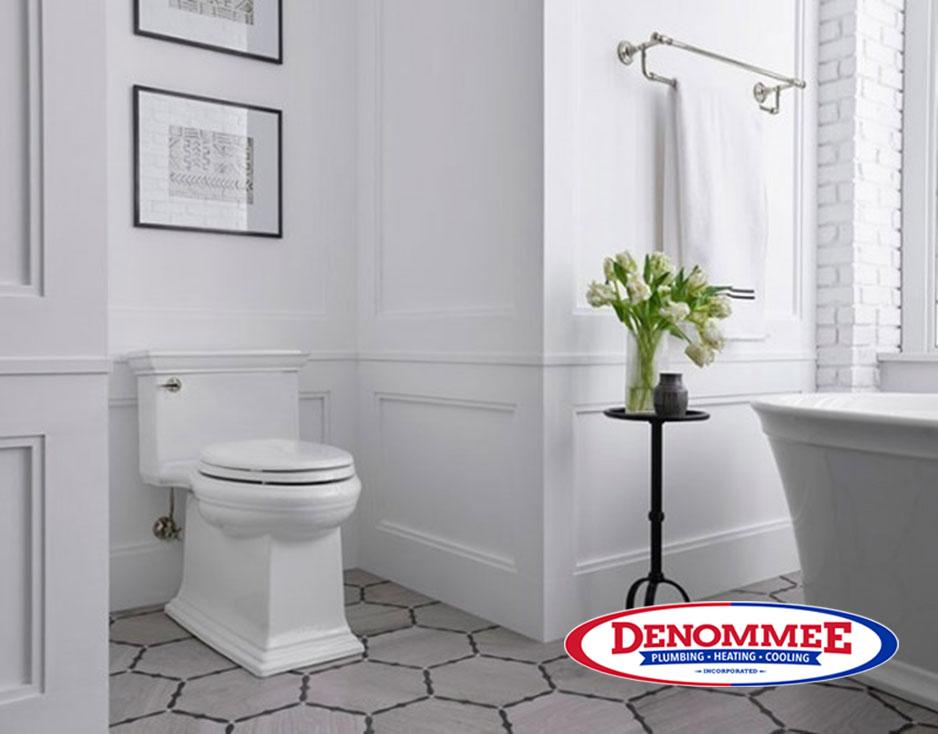
Quick Tips to Stay Timeless.
As you’ve discovered, there isn’t a one-size-fits-all rulebook for decorating and timeless design doesn’t need to adhere to any strict sense of decorum.
However, to ensure your bathroom is in it for the long haul, here are the most popular tried and true things you can do:
- Add a one-piece fully skirted or conceal trap way toilet for a clean look.
- Include a freestanding bath to make a lasting “sculptural” statement.
- Tread lightly with tiled countertops which tend to age more quickly than stone or solid surfaces.
- A light neutral color scheme flooded with natural daylight will keep your bathroom relevant in any age. Play off the architecture of your home to create a harmonious environment.
- Stay true to your own personality in every detail and you can’t go wrong.
- Incorporate finishes , such as nickel or marble, that have proven themselves as relevant throughout several historic eras.
- Stay true to your own personality in every detail and you can’t go wrong.
Choosing a Bathroom Faucet
There are a great number of choices in bathroom faucets. Whether looking to replace an aging bathroom faucet, or are creating an entire new bath, at Denommee Plumbing, Heating & Cooling, you have a trusted partner and resource in getting all your bath plumbing needs addressed cleanly, promptly and professionally. Call us at 978-649-8886 for a free in-home consultation or simply request bathroom plumbing service and book appointments right here on our website.
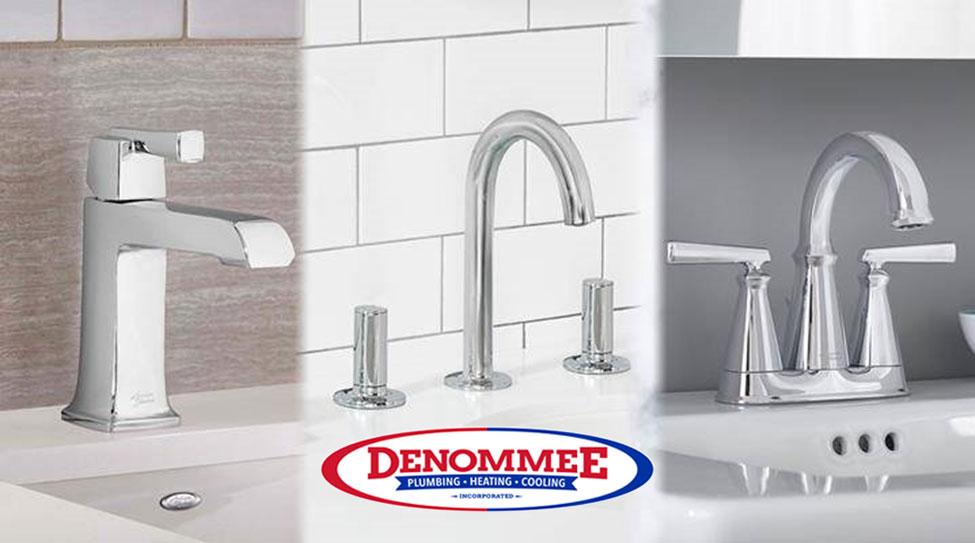
Style
Avoid a tiny faucet on a big, bold sink, and vice-versa. Also make sure that the style, such as contemporary or traditional, matches that of the sink. Look for a faucet that directs water into the center of the bowl. For a large sink consider a tall gooseneck or one with a pull-out spray. If the faucet’s too short, it may not reach far enough. Make sure your new faucet matches the correct hole drillings in your sink, 4″ centers, 8″ centers, or single hole.

Handles
How many and what type of handles do you desire? Our designs range from traditional cross handles to contemporary single-lever and two handle models. Lever handles in both single and dual control designs are not only stylish, they’re also the easiest to use for people with smaller or less flexible fingers.
Mounting
To keep things interesting, we offer a variety of faucets that mount directly to the sink, a faucet deck, countertop, or wall. As with hole patterns, make sure that your faucet is compatible with your sink especially when it comes to vessel sinks which require tall countertop mounted vessel faucets or wall-mounted faucets.
Holes
Choosing a 3-hole sink with a 4″ spread gives you the most faucet options, including the use of a 4″ center set, 4″ mini-spread or a center-hole faucet with a base plate. However, some people prefer the simplicity of center-hole designs, or the traditional appeal of 8″ spreads. The choice is yours to make and enjoy.
Dripless Faucets
Consider how a new faucet will last. Or, more importantly, how long it will last without dripping. Faucets should offer long-term performance and be drip-free for life. Ceramic Disc Valving utilizes discs made of hardened ceramic, a durable material that won’t wear out and won’t leak even under the toughest water conditions.
Pull Out
Select bathroom and kitchen faucets feature a pull out or pull down spout in which the end of the spout of the faucet can e ‘pulled out’ from the rest of the spout similar to a side spray. These faucets allow you to bring the water flow to where you need it in the sink.
Choosing a Toilet
In Denommee Plumbing, Heating & Cooling, you have a trusted partner and resource in getting all your bath plumbing needs addressed cleanly, promptly and professionally including toilet repair, sales and installation. Call us at 978-649-8886 for a free in-home consultation or simply request bathroom plumbing service and book appointments right here on our website.

Recent thinking regarding the bathroom space focuses on lifting daily rituals out of the realm of utilitarian. Even toilet innovation centers around bringing renewed personalization and a sense of well-being to these rituals. So, choosing a toilet requires a bit of consideration and decision-making upfront. The following guide will help you discover the toilet best suited to you and your home.
Considerations to Keep in Mind
Here are a few questions to get you started. And don’t worry if you don’t know the answers right now. Talk to us, we will help you answer them as you explore.
- Is your toilet for a master, guest or kids’ bathroom? Your answer may influence the features you choose, from cleansing or bidet functionality to an easy-to-clean design.
- Are you replacing a toilet, remodeling your bathroom or building a new home? If you’re replacing only the toilet you may want to choose the same footprint to avoid gaps with the existing floor.
- Who will be using the space? Anyone who has difficulty sitting and standing? Some toilets are taller than average to make getting up and down easier.
- Have you considered a toilet with bidet functionality? Toilets that offer personalized cleansing are changing the way people think about this private ritual.
- How would you define the style of the bathroom? With so many toilet styles available, you can match the design detail and color of your toilet to the overall bathroom.
Toilet Types
Toilet type is defined by how many pieces make up the toilet – one or two – and how the toilet is installed – on the floor or on the wall. Most toilets installed in the U.S. are two-piece toilets that are mounted on the floor. Keep in mind that if you’re interested in advanced features like bidet functionality and personalized cleansing, you will need to have an electrical outlet installed close to the toilet.
Two-Piece Toilets
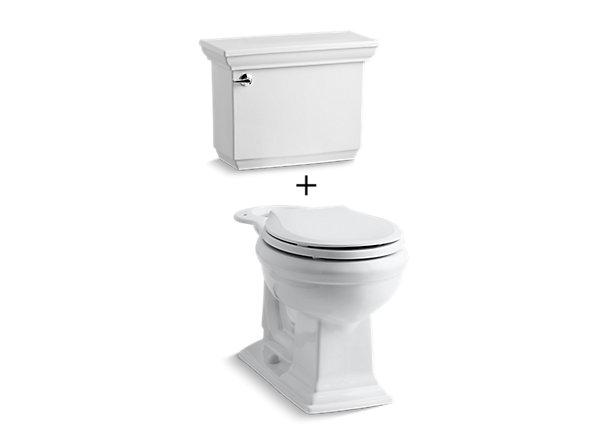
This is the most common type of toilet installed in residential settings, and it offers great value. A separate tank and bowl are assembled to create the full toilet.
One-Piece Toilets
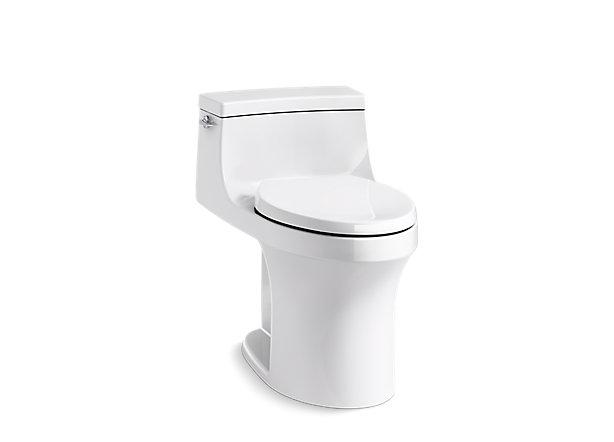
A one-piece toilet is crafted from one single piece of ceramic, so the bowl and tank are integrated. This eliminates the seam between the bowl and tank, making it easier to keep clean.
Intelligent Toilets
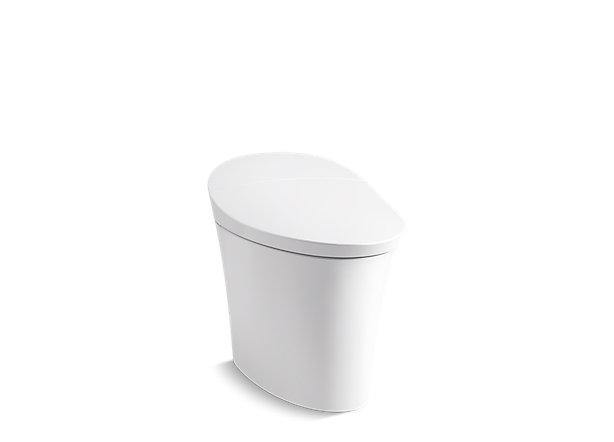
From heated seats and warm water cleansing to automated flushing and more, intelligent toilets help redefine one of life’s most basic rituals.
Leading-Edge Design
Intelligent toilets features an innovative tankless design that makes a stunning style statement.
Cleansing
From heated seats and warm-water bidet functionality to automated flushing and more, intelligent toilets help redefine one of life’s most basic rituals.
Adjustable Settings
Temperature, cleansing settings and more can be controlled with an intuitive touch-screen remote.
Wall-Hung Toilets
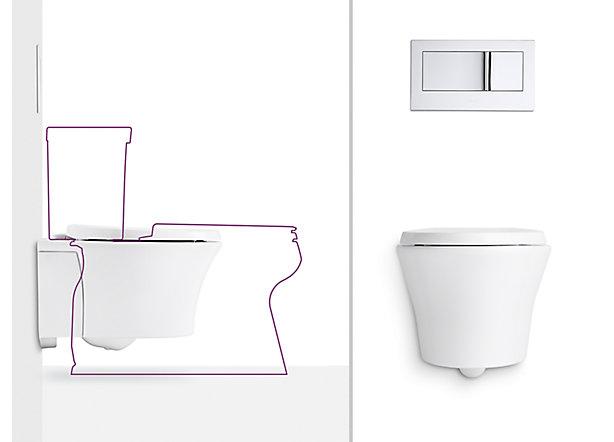
Ideal for bathrooms with a limited footprint, a wall-hung toilet features a sleek, easy-to-clean design. With a hidden in-wall tank, only the bowl and flush plate are mounted to the wall, resulting in a streamlined profile that saves up to 12″ of space over floor-mount models and simplifies cleaning.
Rough-In Measurement
To ensure your new floor-mount toilet fits your space, measure from the wall (not the baseboard) to the floor bolts that attach the toilet to the floor. This is the rough-in measurement. The most common rough-in is 12″.
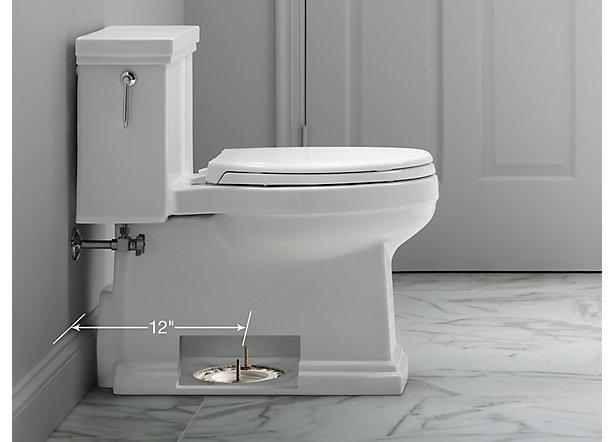
To ensure your wall-hung toilet fits your space, measure the depth of the wall studs which will hold the in-wall water tank. These tanks come in sizes that coordinate with 2″ x 6″ or 2″ x 4″ studs. You will need to choose a tank that matches.
In Denommee Plumbing, Heating & Cooling, you have a trusted partner and resource in getting all your bath plumbing needs addressed cleanly, promptly and professionally including toilet repair, sales and installation. Call us at 978-649-8886 for a free in-home consultation or simply request bathroom plumbing service and book appointments right here on our website.
Toilet Design
As you choose your toilet, you will want to consider a few details that will have an impact on the overall space as well as ease of use and cleaning. From the footprint to the position of the flush handle, the small details will create the experience you’ll have.
Denommee Plumbing, Heating & Cooling is your trusted partner and resource in getting all your bath plumbing needs addressed cleanly, promptly and professionally including toilet repair, sales and installation. Call us at 978-649-8886 for a free in-home consultation or simply request bathroom plumbing service and book appointments right here on our website.
Bowl Shapes
Bowl shapes have varying lengths. Knowing what the shape of your toilet bowl is – round, elongated or compact elongated – will be important when you choose a coordinating seat. Round bowls are usually space-saving while elongated offer more comfort for adults.
Elongated Toilets
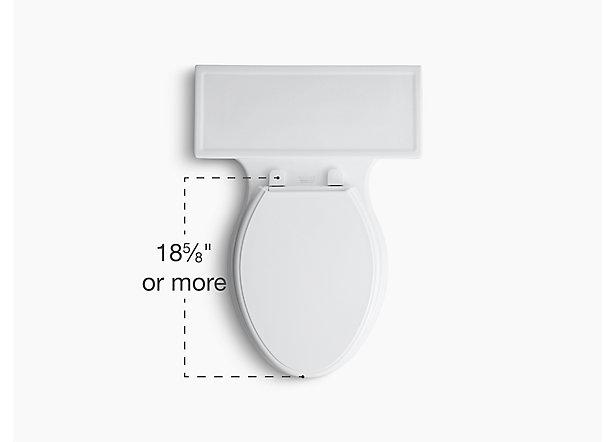
- Fits most residential spaces
- Provides added room and comfort for seating
- Length from back of tank to nose of bowl – 28-1/2” – 31-5/8”
Compact Elongated Toilets
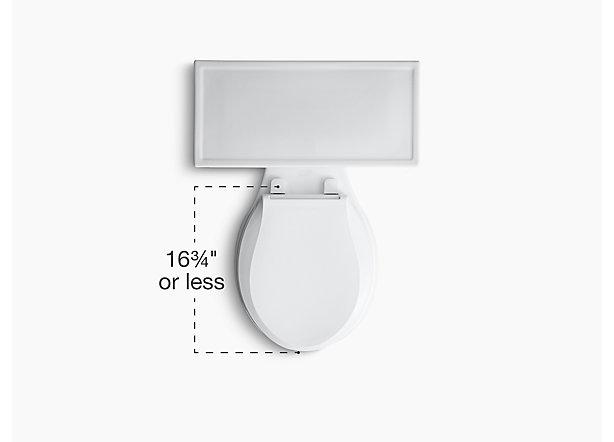
- Offers the comfort of an elongated bowl in a round-front toilet footprint
- Saves up to 10 percent more space than an elongated bowl
- Length from back of tank to nose of bowl – 26-3/4”- 28-1/2”
Round-Front Toilets
- Requires less space
- A good solution for small spaces
- Length from back of tank to nose of bowl – 25-5/8” -29-3/4”
Seat Heights
Toilet height is measured from the floor to the top of the seat. Heights vary enough to be noticeable. Most often, they fall somewhere between 15” and 19”, with standard toilets coming in under 17”. However, chair height toilets, what Kohler refers to as Comfort Height® toilets, measure 17” or more.
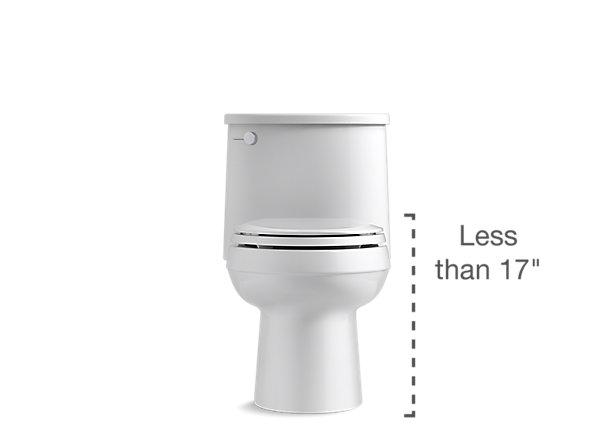
Standard Height Toilets
- Ideal for people of average or smaller stature
- Low-profile
Chair Height Toilets
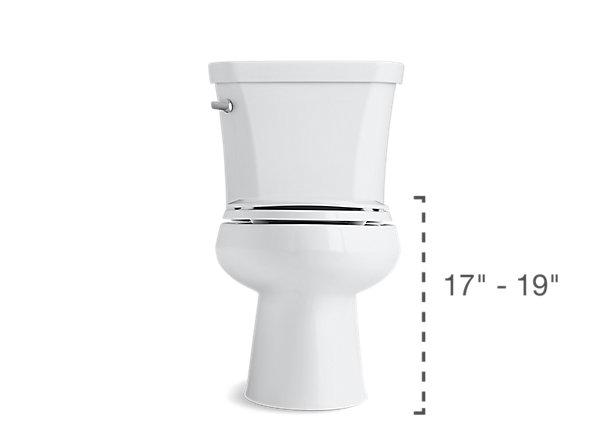
- Sits at chair height–approximately two inches higher than standard-height toilets
- Makes standing and sitting easier
- Many are ADA-compliant when installed per applicable guidelines
Custom Height Toilets

- Wall-hung toilets can be positioned at a custom height from 15-3/8″ to 28-1/2″ to accommodate a range of statures
- Raised bowl allows cleaning underneath
Toilet Trapways
The trapway carries waste from the bowl to the piping that leads to your sewer line. Toilets with fully glazed trapways help eliminate clogging. The S-shape of the trapway can be exposed, concealed or completely hidden with a skirted design.

Exposed Trapway Toilets
Traditionally designed, exposed trapways can be seen from the side of the toilet.
Bolt Caps
Exposed trapway toilets are fitted with standard caps to cover the bolts that attach the toilet to the floor.

Concealed Trapway Toilets
Features a smooth trapway surface that’s easy to wipe clean.
Low-profile bolt caps
Low-profile bolt caps replace traditional raised caps for a smooth, easy-to-clean surface on toilets with concealed trapways. Clean Caps™ is the term Kohler uses for these low-profile bolt caps.
Browse Kohler concealed trapway toilets.

Skirted Trapway Toilets
Offers an easy-to-clean uniform toilet base from front to back.
Clean Installation
No bolts are exposed with a skirted toilet, and many models don’t require drilling, caulk or special tools to install.
Browse Kohler skirted trapway toilets.
Denommee Plumbing, Heating & Cooling has the experts for all your bath plumbing needs addressed cleanly, promptly and professionally including toilet repair, sales and installation. Call us at 978-649-8886 for more information, to book service, or to schedule a free in-home consultation, simply click right here on our website.
Showers: Size & Type of Bathroom
The size and type of bathroom you’re working with will influence everything in your shower, from spray functions to storage considerations. Denommee Plumbing, Heating & Cooling is your trusted partner and resource in getting all your bath plumbing needs addressed cleanly, promptly and professionally including shower repair, sales and installation. Call us at 978-649-8886 for a free in-home consultation or simply request bathroom and shower plumbing service and book appointments right here on our website.
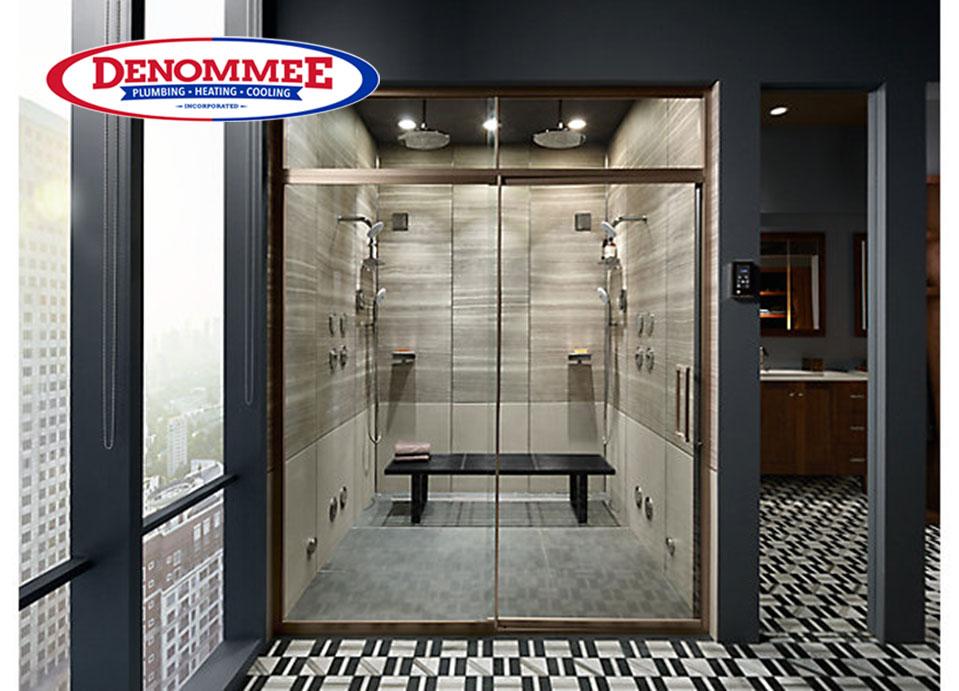
Master
This is typically the shower where you may want to include personalized and spa like features. More than a place to get clean, the master bath shower is often a place to destress and recharge. These specific guides will help.
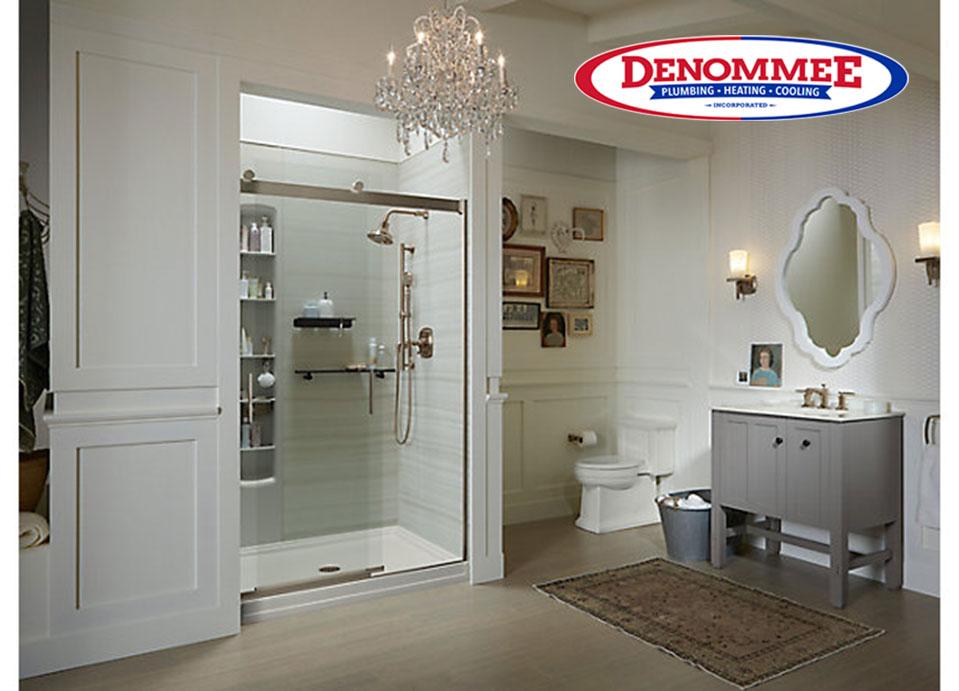
Guest
Often guest bathrooms are three-quarter baths with a stand-alone shower. Because your guests will be of varying heights, a hand shower with slidebar is often a better bet than a showerhead.

Kids & Pets
A shower space that’s great for washing up children and pets typically includes multiple spray functions that are soft enough for a child’s skin and effective enough to rinse pets clean.
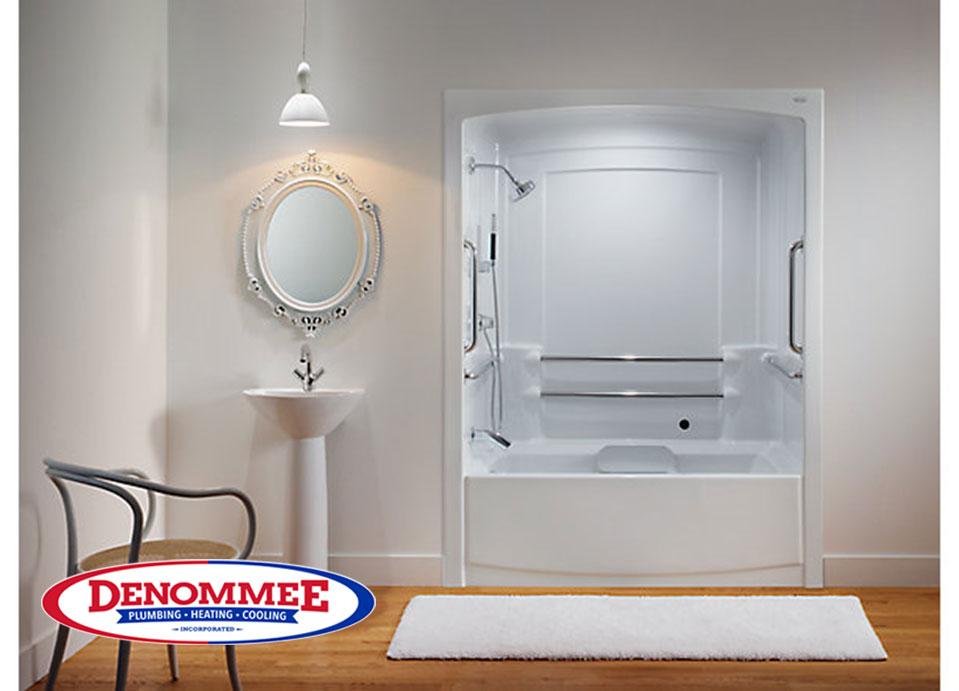
Health & Safety
For people who have limited mobility now, or are making plans for the future, it’s possible to create an exceptionally stylish shower that still accommodates a range of abilities.
Baths
Baths have become so much more than a quiet space to soak or wash the kids and pets. They still do all that. But now you also can choose from unique experiences that move water, air and sound over your body. Special features like a heated back or color therapy let you personalize your bath even more. The following guide will take you through these and other considerations to help you discover the bath best suited to you and your home.
Denommee Plumbing, Heating & Cooling is your trusted partner and resource in getting all your bath plumbing needs addressed cleanly, promptly and professionally including bath repair, sales and installation for new construction and remodeling projects. Call us at 978-649-8886 for a free in-home consultation or simply request bathroom and shower plumbing service and book appointments right here on our website.
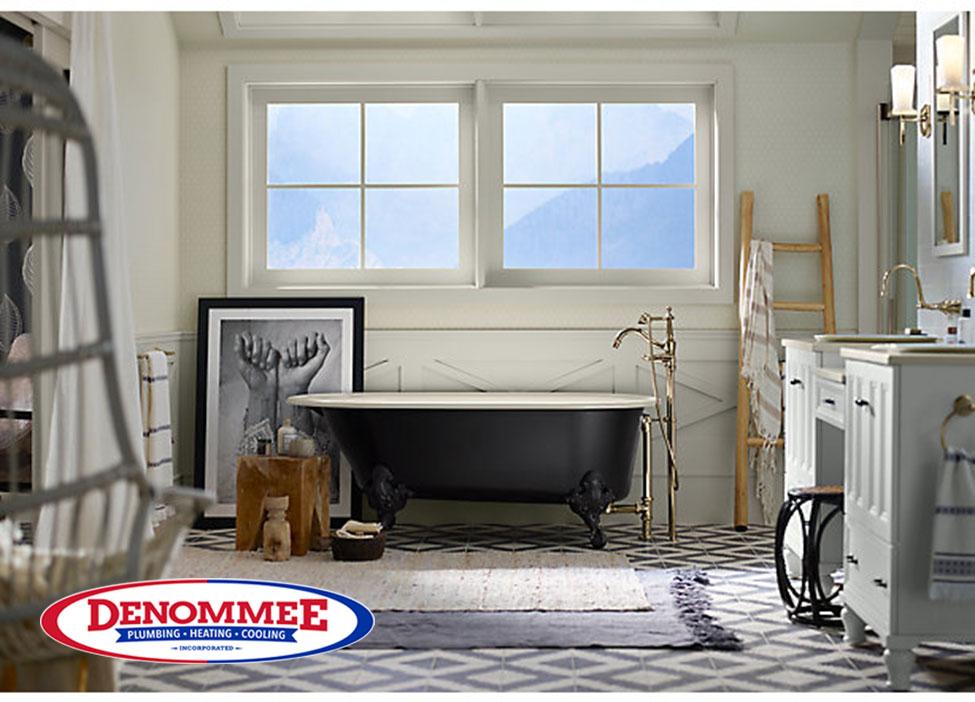
Here are a few thought-starters to keep in mind as you explore. And don’t worry if you don’t have all the answers right now. This guide will help you answer the questions and find solutions that work.
1. Are you replacing a bath, remodeling from the ground up or building a new home? This will help you zero in on which baths are potential matches for your space, particularly if you have space and plumbing constraints.
2. Who will be using the bath? If limited mobility is an issue for anyone, lower heights will make it easier to get in and out.
3. How will it be used? A daily relaxation ritual? Bathing children? Washing pets? How you use the bath should inform the features you choose.
4. How much weight will your floor support? Don’t forget it’s not just the bath’s weight, but the bath and the volume of water once it’s filled. Is your floor sturdy enough?
5. Will your water heater fill the bath without running out of hot water? You’ll need to know if your water heater holds a standard 40 gallons or more and how much water it takes to fill your bath.
Bath Types
Bath types are defined and designed by how they can be installed. For example, the exterior of a drop-in bath is unfinished because it will be hidden by a stone or tile surround, whereas a freestanding bath is finished on all sides and can be installed anywhere in the room.
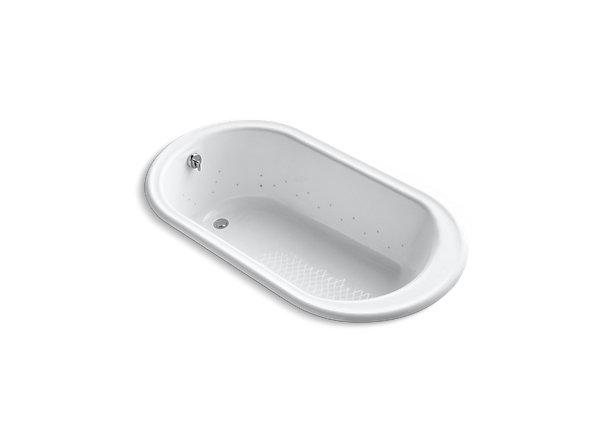
Drop-In Baths
A bath designed for drop-in installation has a self-rimming edge that rests on the deck material–such as tile or stone–that surrounds your whirlpool or bathtub. Kits are available to use your drop-in bath in an under-mount installation.
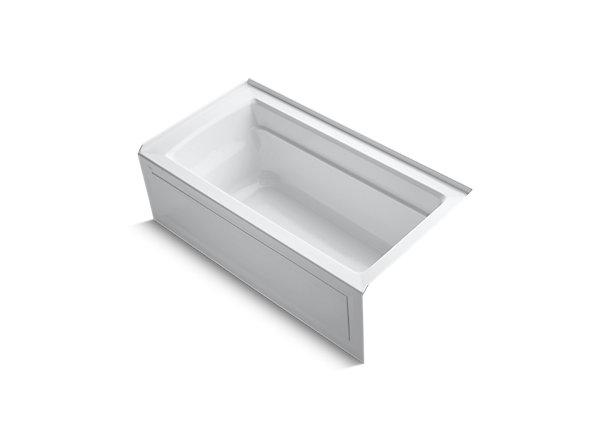
Alcove Baths
An alcove is a recessed nook or area within a room. Designed for three-wall alcove installations, this bath type option typically features unfinished exteriors and tile flanges on three sides. Many of these fixtures include an integral apron, the finished front of the bathtub, to complete the design.
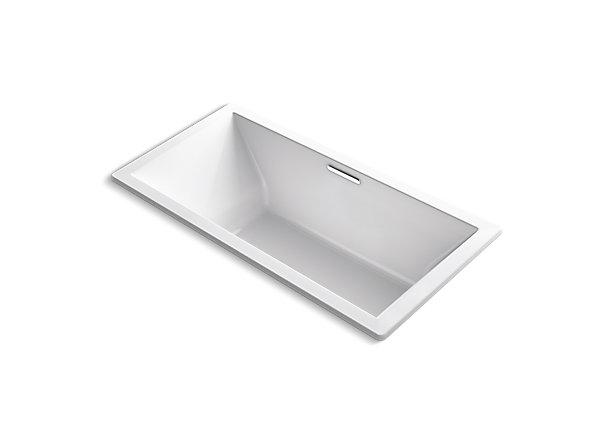
Under-Mount Baths
Creating a clean, contemporary look, under-mount installation is perfect for designing a separate, personalized bathing space. The bath is mounted beneath your choice of deck material, such as tile, solid surface or natural stone. Most under-mount baths can accommodate a drop-in installation.
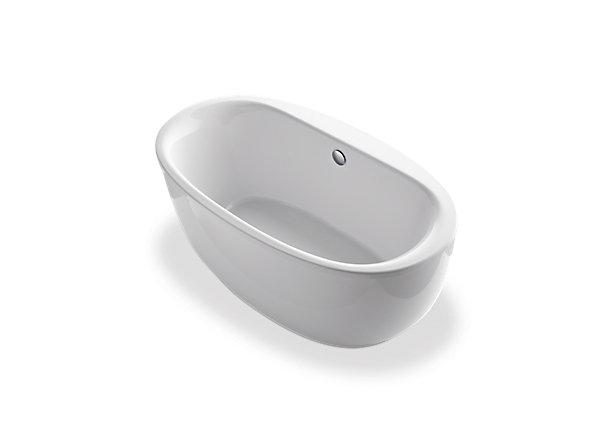
Freestanding Baths
This installation option is ideal when the bath is the focal point of the room. Typically finished and accessible from all sides, the freestanding bathtub highlights the beauty of the design.
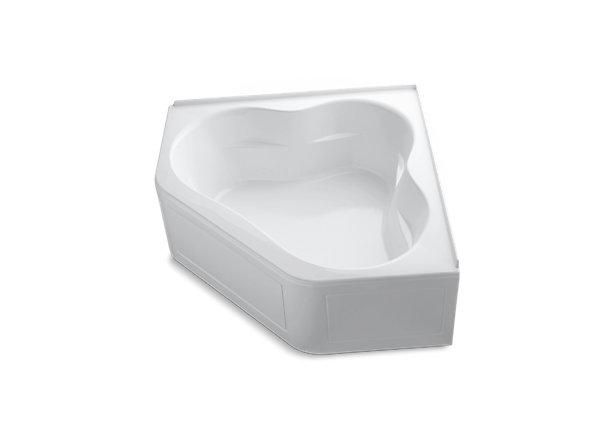
Corner Baths
A corner bath is usually five-sided, with a clover-shaped bathing well, and is designed to accommodate two bathers at once.
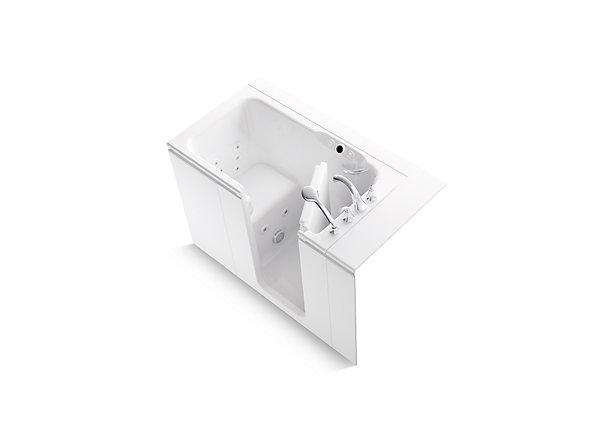
Walk-In Baths
Designed to accommodate bathers who may not be able to step over a standard bathtub threshold, walk-in bath has a side door or a door that opens so bathers don’t need to step over the bath wall.
Size
Baths are available in a variety of sizes, including a range of lengths, widths and heights. The most common bath installation and size is an alcove bath that is 60” x 32”. Measuring your space to ensure the bath you choose will fit is key, but you will also want to think about the people using the bath: Will everyone be able to stretch out comfortably and be totally immersed? Is the bath a comfortable width? Can everyone step over the threshold safely?
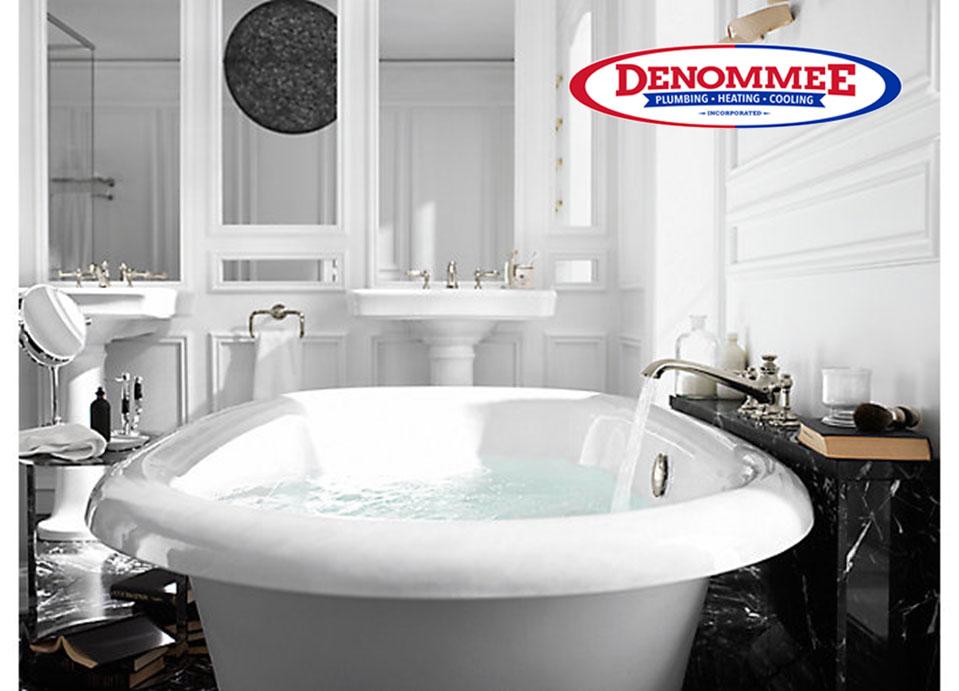
Water Depth
Water depth and bath height are two different measurements. Height is measured from the floor to the top edge of the bath. The most common heights are 15” or 16”. Depth, however, is the measurement taken from the inside of the bath from the base to the overflow drain. Depth, along with length and width, is measured to determine water volume when the bath is filled. On a related note, before you finalize your bath selections, be sure that your floor can support the weight of the full bath and that your water heater will provide enough hot water to fill it.
Baths with shorter than average depths can be an ideal fit for individuals with restricted mobility. The lower threshold makes it easier to enter and exit the bathtub from a standing position or sitting on the edge of the bath and swinging your legs into the bathing well.
Standard for most baths in the U.S., this depth strikes a balance between accessibility and a comfortable soaking depth. Deep enough to cover individuals of average height, these baths offer the best of both worlds.
Baths with extra-deep bathing wells are excellent for soaking. If you plan to include one or more hydrotherapies in your bathtub, a depth of 16” or greater will make the experience all the more enjoyable.
Kitchen Plumbing
Kitchen remodel projects can be a simple as a refresh of fixtures to a full-blown demo and rebuild.
Denommee Plumbing, Heating & Cooling can help you realize your dream no matter the scope. have licensed expert plumbers and technicians ready to turn your ideas, dreams and needs into reality. Our service is legendary, and we have decades of combined experience in getting bathroom plumbing done right and at the right price. We make working with us easy and fast. We have access and experience with a wealth of brands and high-quality kitchen plumbing fixtures. Getting started is easy, read on below for helpful info, and then call Denommee Plumbing, Heating & Cooling at 978-649-8886 for a free in-home consultation or simply request kitchen plumbing service and book appointments right here on our website.
The Work Triangle
Kitchen remodel projects can be a simple (and effective) as a refresh of fixtures to a full-blown demo-and-rebuild. Denommee Plumbing, Heating & Cooling can help you realize your dream no matter the scope. We have licensed expert plumbers and technicians ready to turn your ideas, dreams and needs into reality. Our service is legendary, and we have decades of combined experience in getting kitchen plumbing projects done right, and at the right price. We make working with us easy and fast. We have access to, and experience with a wealth of brands, and high-quality kitchen plumbing fixtures. Getting started is easy, read on below for helpful info, and then call Denommee Plumbing, Heating & Cooling at 978-649-8886 for a free in-home consultation or simply request kitchen plumbing service and book appointments right here on our website.
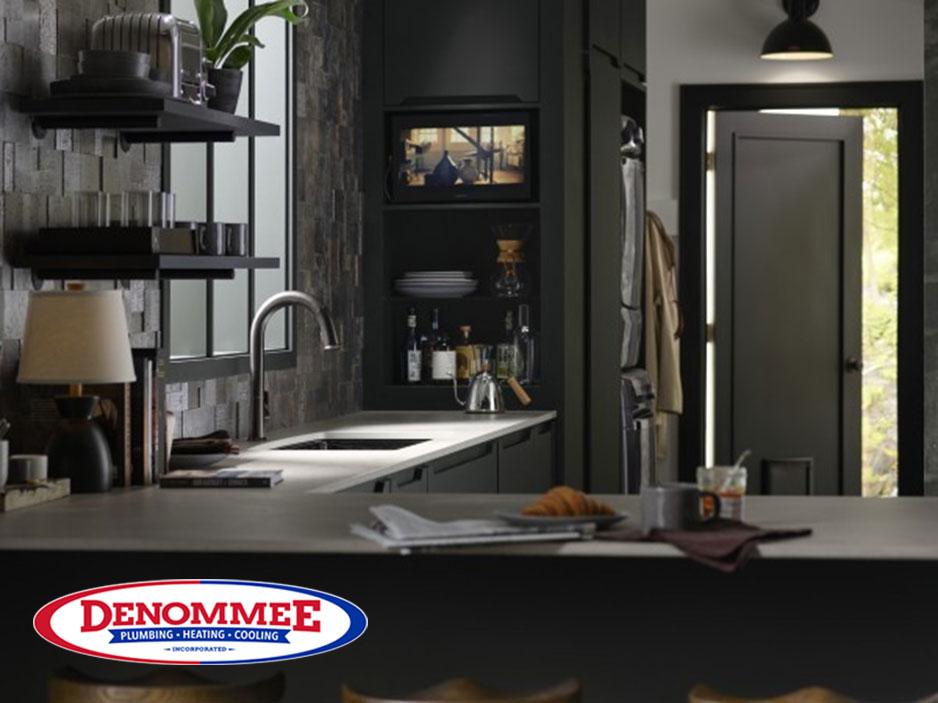
Remember how you swore geometry was one of those useless subjects you would never revisit after high school? It turns out the triangle comes in handy when designing kitchens that offer a streamlined workflow.

No matter what shape your kitchen is in―whether your floor plan is U-shaped, L-shaped, or otherwise―chances are there is a triangle at its heart. And if not, there should be.
If you add up the primary work areas of your kitchen, or any kitchen for that matter, the final count is most likely three: the refrigerator, the sink, and the stove. Now think about how you work between those areas to prepare meals: food taken from the fridge is typically prepared near the sink and transferred to the stovetop or oven. Cleanup happens in reverse.
The triangle is the shortest, most effective path to tread between these three areas and what you should aim to have in your kitchen.
Triangles Equal Happiness
So, your math teacher was right after all; math really is for everyone. It doesn’t matter if your style is rustic farmhouse or modern minimalism, designing around the work triangle will make life in the kitchen more streamlined and more enjoyable. See how these work triangles come to life in actual kitchens.
What’s Your Angle?
If you’re designing a kitchen from scratch, as in a total remodel or new home, you have the opportunity to think through how you use your kitchen and to build with that in mind. Start with the “who.”
Who uses your kitchen?
- You?
- Your partner or roommates?
- Teenagers?
- Kids under ten?
- Is this where everyone hangs out to eat, including the pets?
How do you spend your time in the kitchen?
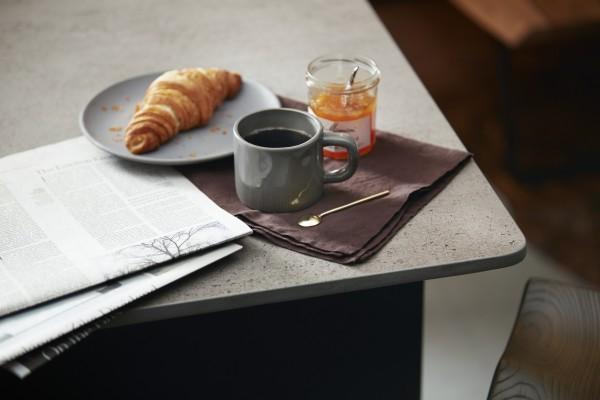
- Cooking or baking?
- Entertaining friends and family?
- Helping kids with homework or projects?
- Merely passing through to toss takeout in the fridge and dishes in the dishwasher?
Thoughtful consideration of who moves through your kitchen, when, and why, can lead you to a smarter plan at the outset. Carefully choosing where the three points of your triangle are situated can be the key to avoiding years of colliding with someone rummaging for milk and cereal while you’re trying to prep a brisket.
Angles, Legs and Elbows
A perfect work triangle in the kitchen allows you to move unimpeded between the three key areas, so for example, you won’t need to navigate around garbage cans or chairs while carrying a heavy pot of boiling water. The work triangle also gives you enough room to avoid bumping elbows with your cooking partner. Ideally, each leg of the work triangle should measure between 4 and 9 feet in length. The total length of all three legs should be between 12 and 26 feet.
Find your kitchen floorplan below and discover where the triangle is situated. Understanding the location of your kitchen’s work triangle can help you keep the path open and move more efficiently from one area to the next.
Is Your Kitchen U-Shaped?

The u-shape has an efficient triangular pathway with ample counter areas to keep food prep, plating and cleanup separate. However, there’s a good chance that if you have a u-shaped kitchen, you may have an island or dining table right in the middle of your triangle.
While either one offers added workspace, consider how it affects the triangle and overall efficiency. It may be beneficial to orient the dining table so it doesn’t obstruct the triangle or to add a cooktop or sink to the island, creating a smaller but more effective triangle.

Is Your Kitchen L-Shaped?
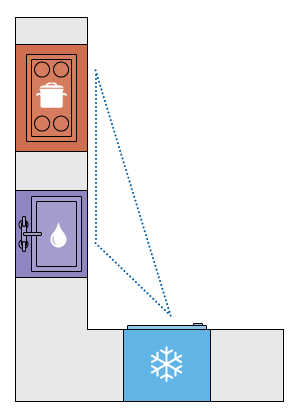
The l-shaped kitchen ideally has either the refrigerator on one wall with the sink and stove on another, or the stove on one wall with the sink and refrigerator on the other. Keeping the sink located between the stove and refrigerator will help you work efficiently.
The sink becomes the hub of prep and cleanup, and the stove and fridge act as satellite workstations. The key here is ensuring that you have counter space on either side of the sink for staging prep and cleanup.
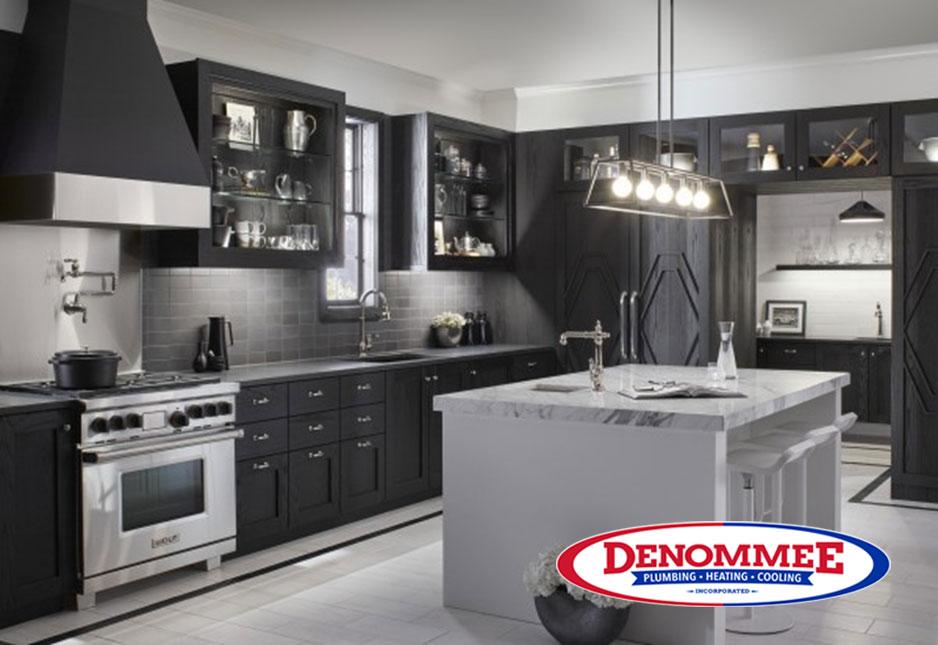
Is Your Kitchen Galley-Shaped?
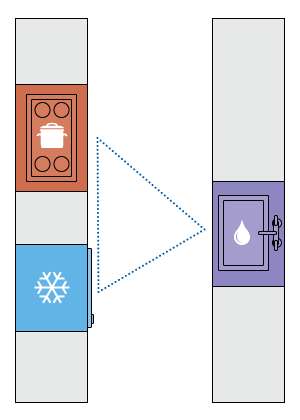
Galley kitchens typically have a more compact triangular pathway. They’re great for the solo chef to move quickly between each area. With a narrow walkway between each side of the galley, moving back and forth from side-to-side shouldn’t require more than a step or two, so energy isn’t wasted.
Limited to Straight Lines?

If your existing kitchen doesn’t have a work triangle, for example a one-wall kitchen where your refrigerator, sink and stovetop are in a straight line, there are simple ways to make your workspace more efficient.
Double-Down on Sinks
Adding a second sink requires a somewhat larger investment, but doubling your functionality is the payoff. If you have ample counter space, you might consider a full second sink to accommodate a second cook. If your space is slightly smaller, however, a prep or bar sink can deliver additional workspace for washing and chopping foods or mixing drinks.
The Pot-Filler Fix
Evaluate the basics: Is the sink in the middle and do you have counter space between each. If the sink isn’t in the middle or conveniently located near the faucet, you might consider adding a pot filler to the stove area. A pot filler allows you to fill a pot at the stove and cuts down on some of cooking’s heavy lifting.
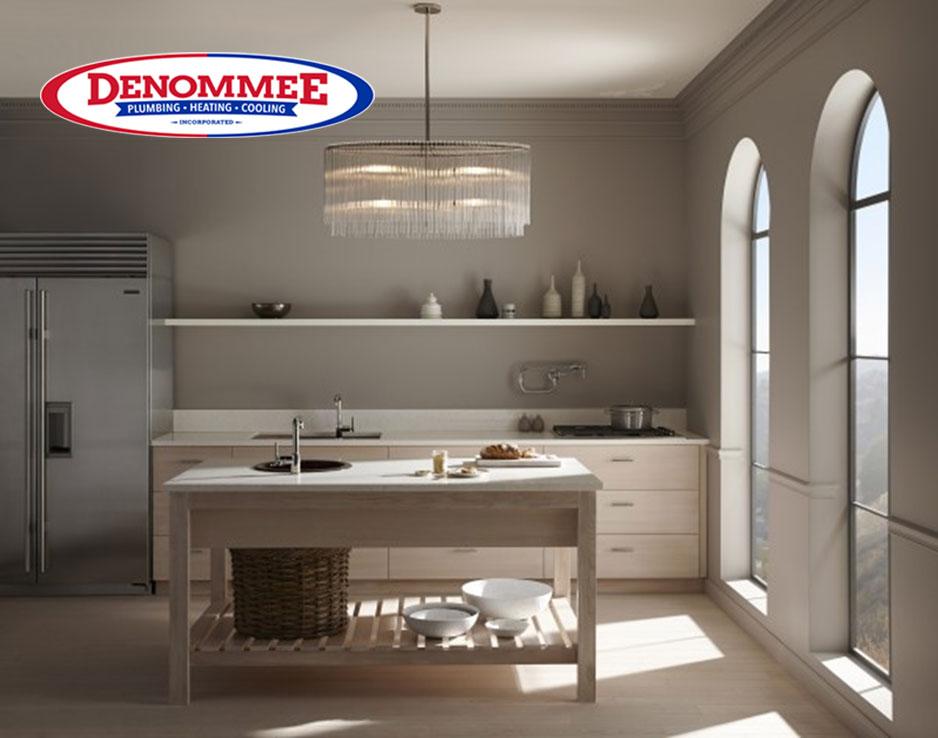
Extend Your Faucet Reach
If a pot filler isn’t a viable option, a pullout or pull-down faucet lets you fill pots, pitchers, coffee makers and more without having to maneuver them into the sink. If the pot doesn’t come to the faucet, the faucet will come to it.
Accessorize for Efficiency
If a lack of counter space between the three points of your triangle is an issue, moving some of that work to the sink itself can alleviate the issue. A sink with built-in stackable accessories, like a cutting board, colander and trays, will give you more space to work between each area, keeping food prep separate and sanitary.
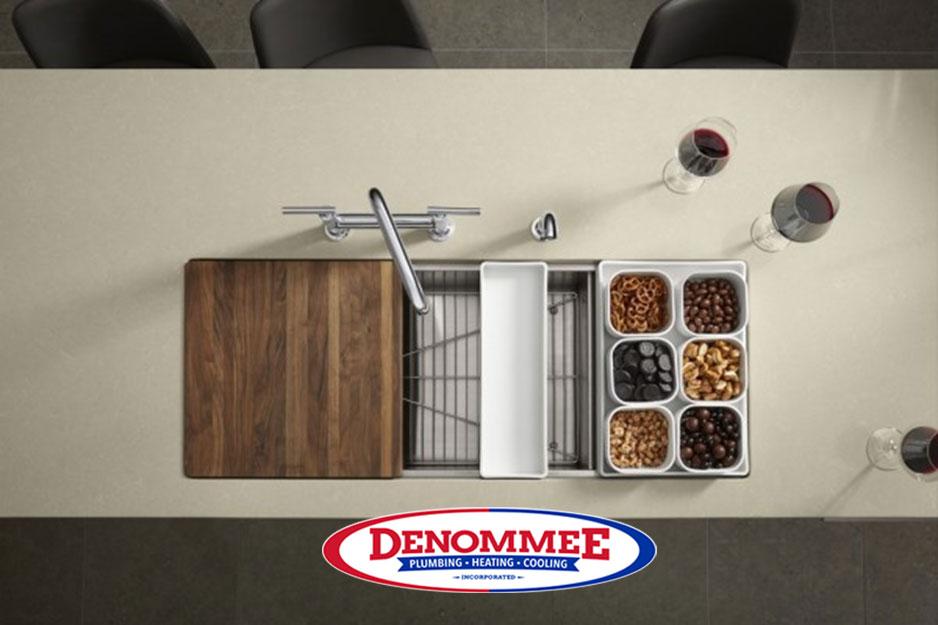
Your Recipe to Conquer Kitchen Clutter
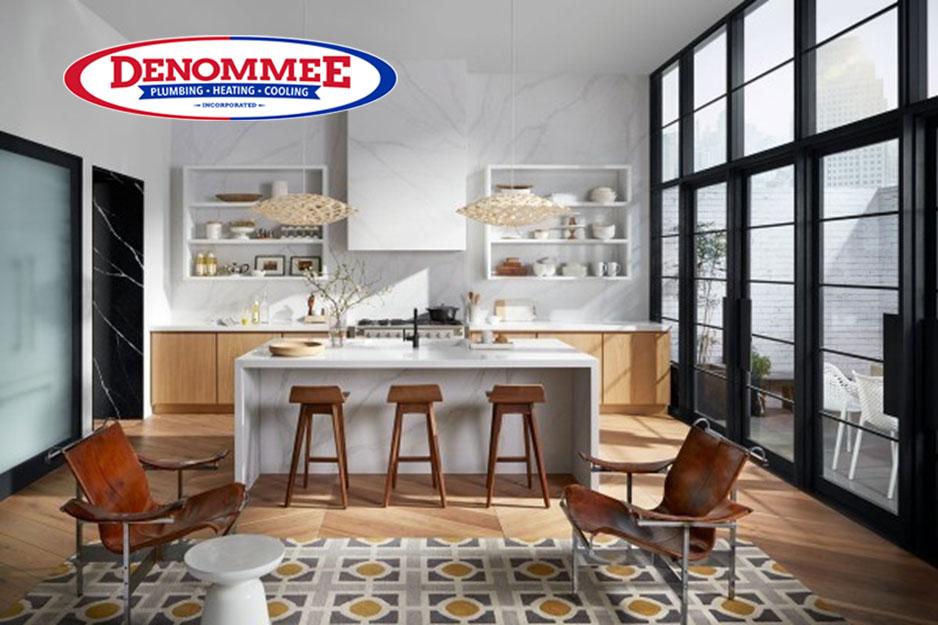
Looking for the secret to easier cleanup, clearing away clutter and getting your kitchen organized once and for all? Zero in on hard-working products that speed up your workflow and keep everything in its place to make kitchen time more enjoyable.
Cut Down on Counter Clutter

Shown: The Riverby under-mount kitchen sink with utility rack, soaking cup, colander and cutting board.
Adding simple storage to your space is a great way to keep your cleaning tools organized and within reach. Pare down the number of sponges, scrubbers and brushes crowding your countertops and drawers by swapping them for tools with multiple uses. Kohler’s kitchen accessories feature a variety of simple, purposefully designed products, from dishwasher-safe caddies to a one-of-a-kind squeegee/brush combination . You could be enjoying a clutter-free kitchen in no time.
Accessorize your Kitchen Sink
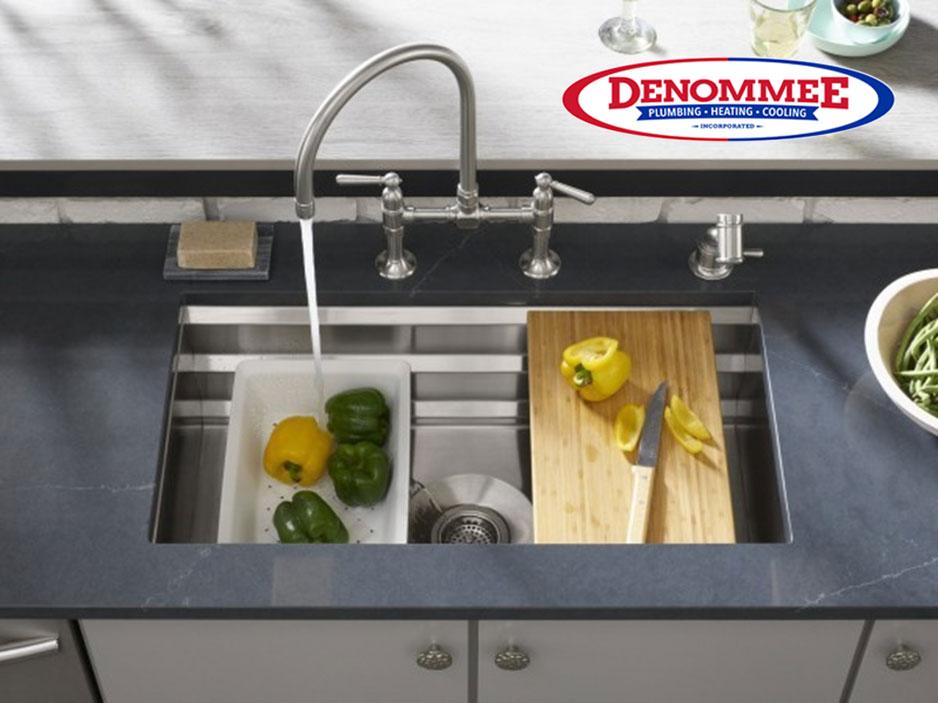
Shown: The Prolific under-mount kitchen sink with bamboo cutting board, colander and washbin.
Many of our kitchen sinks have added accessories like prep bowls, utensil trays, colanders and cutting boards to make cooking and cleaning faster and easier. Using integrated tools within your sink space transforms your standard sink into a fully usable workstation. You’re not only containing your messes to one easy-to-clean area, but you’re also keeping bulky accessories from cluttering your countertops.
Go Hands Free with Your Faucet

Shown: The Sensate Touchless kitchen faucet.
Upgrading to a faucet that accommodates the way you work around the kitchen can save time and effort. And when it comes to function and cleanliness, motion activated faucets just make sense. Touchless technology turns on with the wave of a hand, making messy tasks easier and keeping the kitchen more sanitary ― especially during cold and flu season.
The Final Ingredient
Achieving a cleaner, more organized kitchen that you love is doable without a remodel. You just need the right recipe and the active ingredients to make it work and the right company to help you make it happen―Denommee Plumbing, Heating & Cooling. Conveniently request our kitchen plumbing service and book free in-home consultation appointments right here on our website.
Kitchen Remodeling Myths
It’s easy to fall prey to common misconceptions when planning a new kitchen or renovation, so we’re setting the record straight to get your started on the right foot.
Myth 1: You Don’t Need a Specific Goal for Your Kitchen Remodel
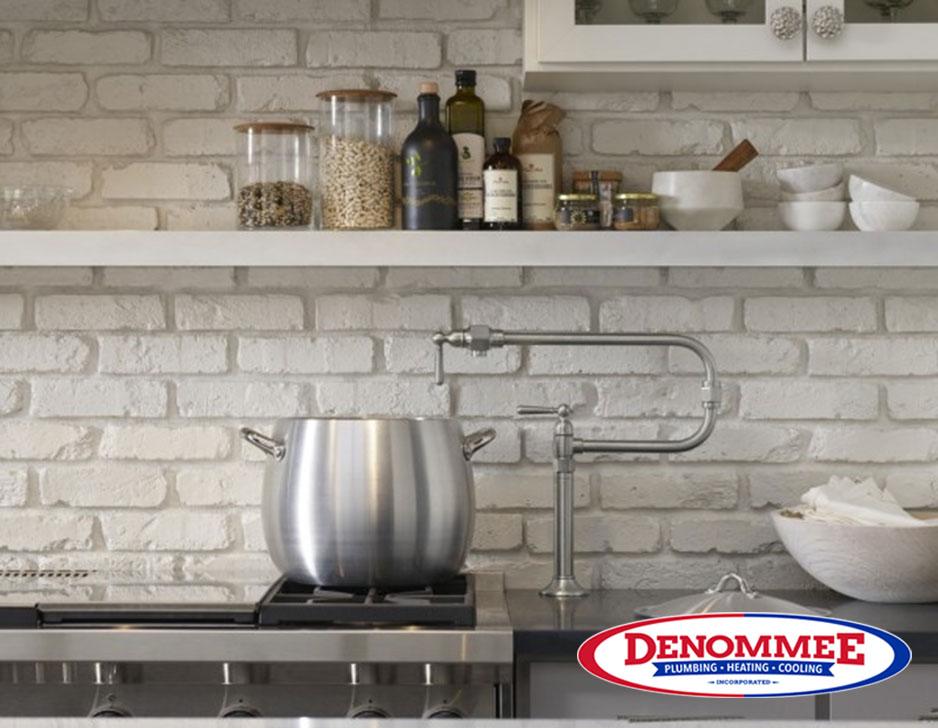
Shown: The HighriseTM kitchen pot filler
All projects should have a goal in mind, and a kitchen remodel is no exception to this rule. Your goal should go beyond just having an updated space. Consider whether resale value is important to you and think about how you use your kitchen. Is this your forever kitchen? If that’s the case, focus on making it your own and having the kitchen design fit your tastes exactly, no matter how unique they may be. Do you cook large meals frequently? If not, maybe you don’t need that top-of-the-line range you’ve been eyeing that’s too large for your space anyways. On the other hand, if you’re a home chef, perhaps it’s time to consider adding a prep station and pot filler to make cooking that much easier and streamlined.
Myth 2: You Don’t Need a Designer
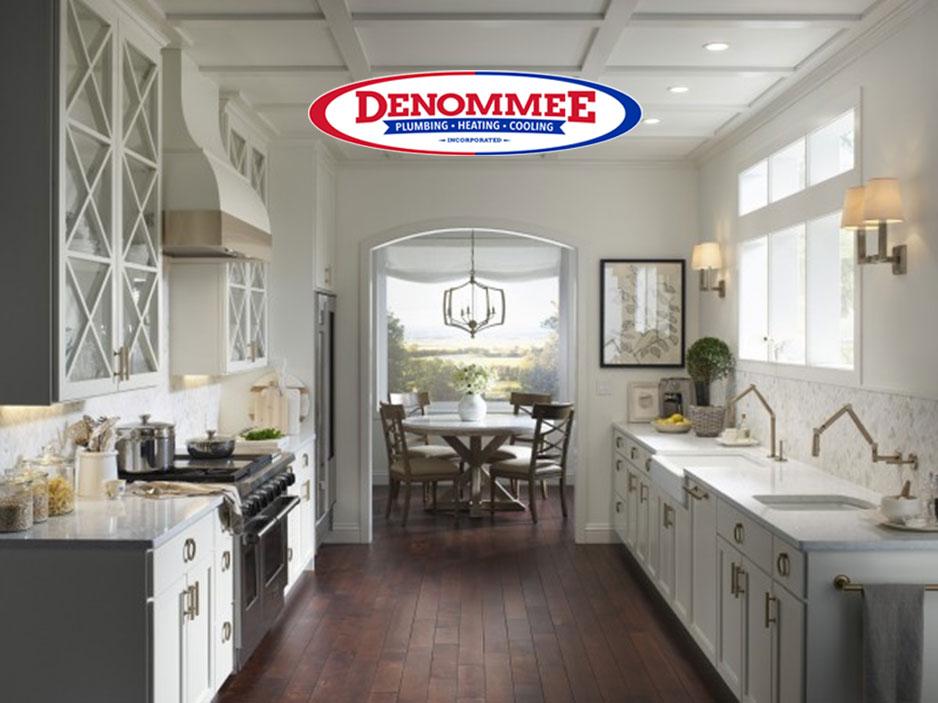
Getting started on your dream kitchen remodel doesn’t have to be difficult or overwhelming; call Denommee Plumbing, Heating & Cooling at 978-649-8886 for a free in-home consultation and consider visiting your local KOHLER showroom for further design help.
While not every project requires a designer, most can certainly benefit from one. Kitchen design comes with many idiosyncrasies. For example, whether you’re right-handed or left-handed; the answer could greatly impact how a designer would approach your kitchen layout. Additionally, having a designer onboard will also make it easier to track your budget and the bigger picture to ensure your dream kitchen can become a reality.
Myth 3: Kitchen Storage is Less Important than Kitchen Style
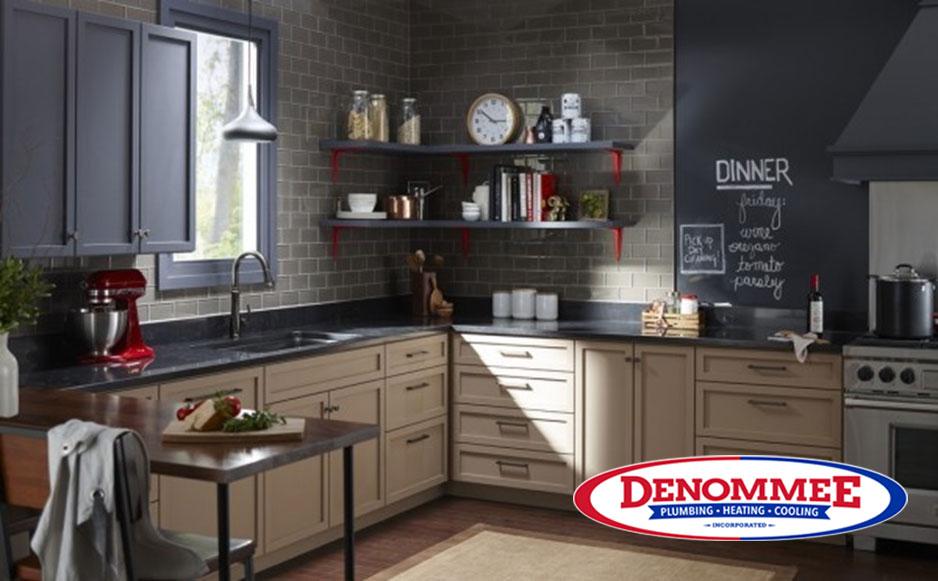
Ideally, there should always be a balance between functionality and style; both are equally important to consider when planning a remodel. Whether we like it or not, life is messy and that’s why adequate storage space is essential. A good way to understand just how much storage space is needed is to take stock of what you actually use in your kitchen, from food items to dishware and everything in between to eliminate kitchen clutter.
Myth 4: A Bigger Kitchen is Better
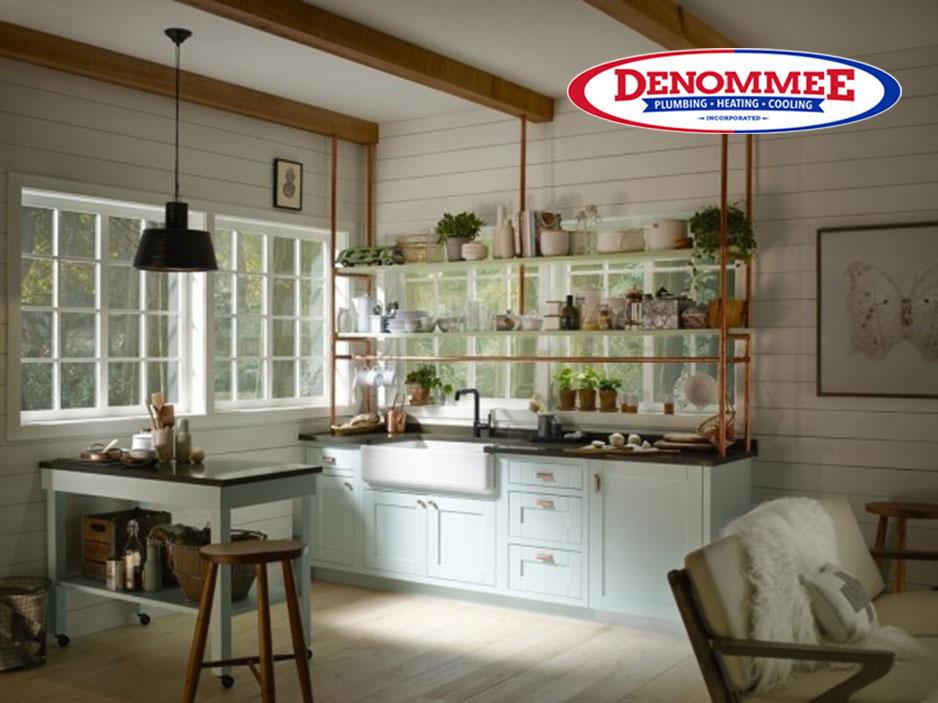
Shown: The Copper Cottage Kitchen Designed by Kim Lewis
It’s a common misconception that the larger a kitchen is, the better it will be when it comes to functionality. While you definitely want and need space to move and work, a room’s functionality isn’t dictated by its size, but instead by its layout and efficiencies. Smart kitchen planning is key, like thinking through the work-flow, selecting sinks with multiple accessories and being mindful of the kitchen work triangle.
Here’s to a seamless remodel or renovation in one of our favorite rooms in the house!
Call Denommee Plumbing, Heating & Cooling at 978-649-886 or conveniently request our kitchen plumbing service and book free in-home consultation appointments right here on our website.
Some things are just better together, especially in the kitchen. It could be a case of opposites attracting, like a black and white color palette or creamy and crisp flavors that blend just right. Perhaps it’s a pair of objects that together create a perfect combination of function and beauty. Either way, when the pairing is perfect, you just know it.
Kitchen Sink and Faucet
The perfect sink-and-faucet pair is the key to an efficient work space, defining the way you prep, cook, and clean up. The right products bring energizing color and engaging style to your kitchen, laundry room, mudroom and bar. Whether sleek and streamlined or steeped in vintage style, there’s a perfect pair for every size and type of kitchen. With so many options, though, how do you choose the right ones? Here are a few things to think about as you start to plan.
Consider Your Needs
Location. Which spaces in your kitchen, bar, or laundry room will need a sink and faucet? Maybe your kitchen could gain efficiency from an extra sink and faucet on the island, or a pot-filler faucet near the cooktop.
Material. Would you like a sink in enameled cast iron, stainless steel, or composite material? Each material has its own benefits and distinctive look.

Style. Consider which sink and faucet style and installation options will best meet your needs. Does your taste run more toward traditional looks, modern styles or somewhere in between? Do you like the look of a farmhouse sink? Do you plan to replace your countertops? If you do, you’ll have more options for your sink type.
Features. Have you considered additional components, like a sink that includes convenient accessories like basin racks, cutting boards, and colanders or a faucet with multiple spray options? There’s a huge range of features available that can help make your kitchen routines much more efficient.
Finish. Think about which faucet finish will best coordinate with the other elements in your kitchen. Do you like the look of stainless steel, a soft brushed nickel, or a rich bronze?

Get Inspired
Check out two perfect sink-and-faucet pairings, designed to work together for maximum efficiency and stunning good looks. And if you need more ideas, explore our favorite kitchen trends.

This is truly one hard working pair. The stainless steel sink has three levels, so you can place the included bamboo cutting board, grated racks, colander, and wash bin exactly where you want to suit the way you work. And the Sensate faucet is Prolific’s perfect partner, speeding you through tasks without spreading messes. Its high-arching spout is not only practical, it adds a sculptural aspect to any style of space. Together, this dynamic sink-and-faucet duo bring an ideal blend of beauty and brains to the kitchen.
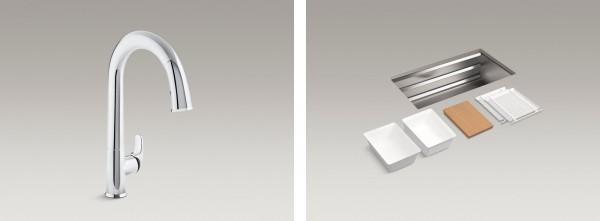
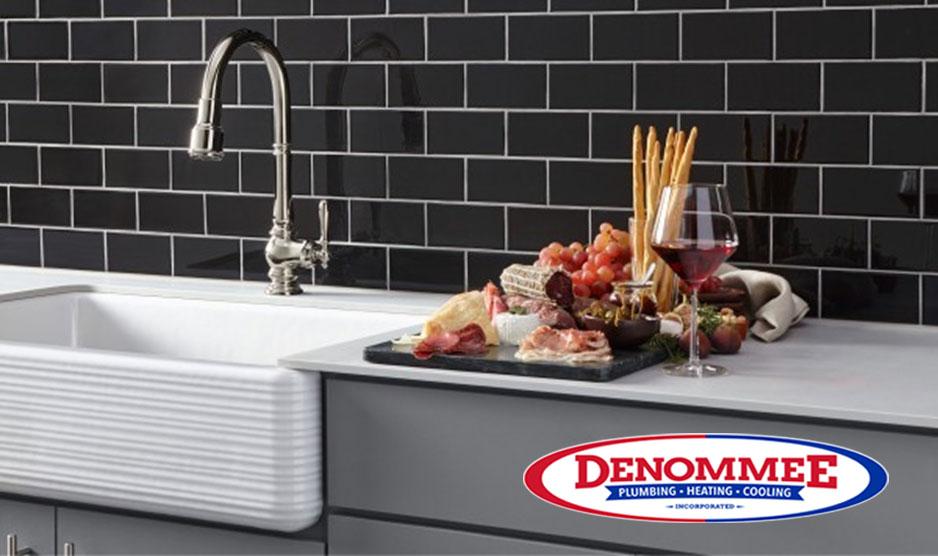
This thoughtful pairing proves that some things are just better together. The tactile design on its apron-front adds a modern element to the traditional farmhouse-style sink, with its trademark large basin. The pull-down faucet sweeps across and around every corner for maximum cleanup efficiency. It even has a soft spray function that babies tender berries and seafood. The faucet’s vintage detailing combines with the sink’s updated farmhouse vibe for a look that’s both of-the-moment and timeless.
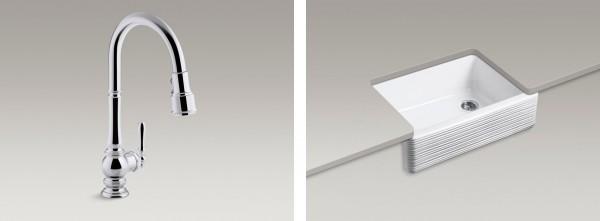
Want to create a look you’ll love? Explore sink, faucet, countertop, wall color, and cabinet options with the Kohler interactive kitchen planner . And then, call Denommee Plumbing, Heating & Cooling at 978-649-886 or conveniently request our kitchen plumbing service and book free in-home consultation appointments right here on our website.
Farmhouse Sinks
There’s something about farmhouse sinks that hearkens back to a simpler era. These utilitarian fixtures reflect a hard-working history as everything from canning workspaces to washbasins for dogs and small children. No wonder they’ve long been an iconic element in traditional-style kitchens. They’re becoming increasingly popular in contemporary spaces, too, thanks to fresh twists on colors and materials and easier installation options. At Denommee Plumbing, Heating & Cooling, we have experts and a wealth of experience in installing and servicing farmhouse kitchen sinks. Call us at 978-649-886 or conveniently request our kitchen plumbing service and book free in-home consultation appointments right here on our website.
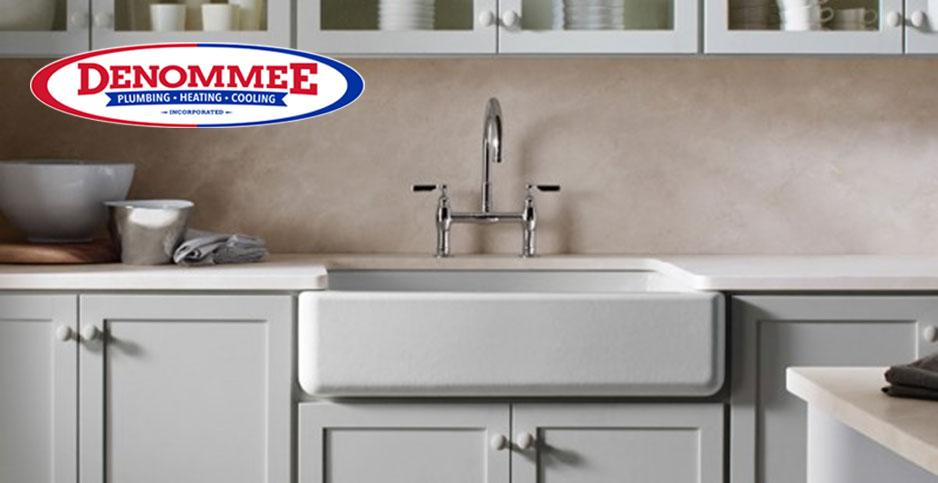
Form Meets Function

One of the keys to farmhouse sinks’ popularity is their unique combination of beauty and functionality. Available with a wide single-bowl or a double-bowl with a lower divider, farmhouse sinks are large enough to accommodate oversized cookware and cookie sheets, and their distinctive form creates a stunning focal point in the kitchen. The Whitehaven Hayridge sink takes the farmhouse sink in a decidedly artful direction, with its distinctive pattern of horizontal ridges that adds a tactile quality.
Easier, Cleaner and Comfortable
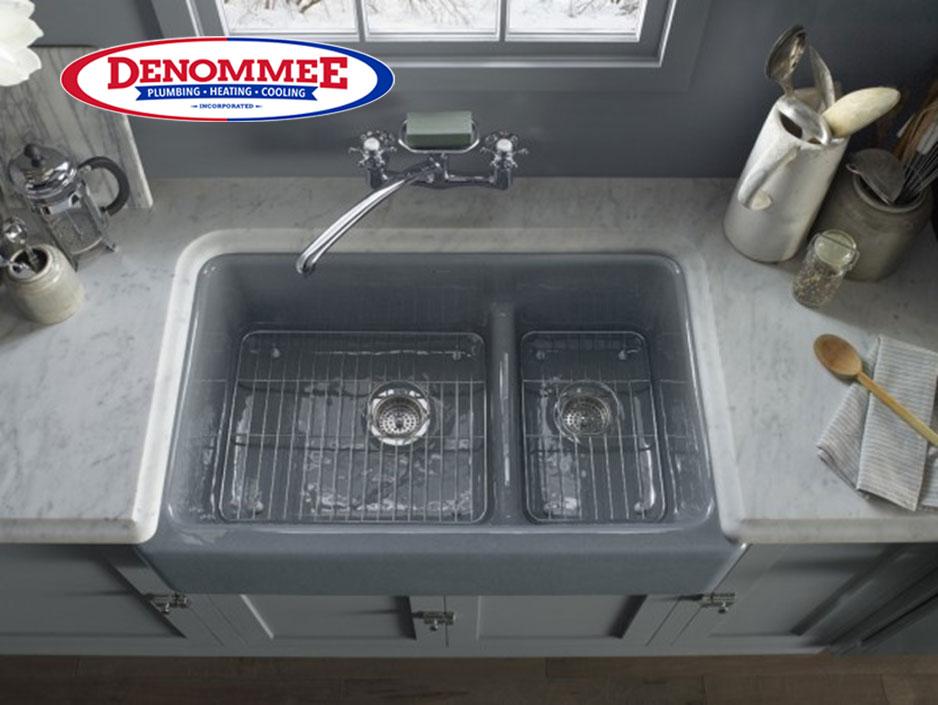
Farmhouse sinks are also ergonomically friendly. Often oriented farther forward than typical drop-in or under-mount sinks, they let you get closer and work with less stress and strain. The classic deep bowl of the farmhouse sink also means less splashing and fewer puddles on surrounding surfaces.
Classic, Yet Modern

Along with the kitchen, the farmhouse sink has undergone some evolutionary changes of its own. Fresh shapes, new colors and decorative designs coordinate with an unprecedented array of styles.
When it comes to materials, enameled cast iron remains popular for its beauty, strength and durability. KOHLER enameled cast iron sinks are guaranteed not to chip, crack or burn–and they’re available in an expanded range of color, pattern and shape options. To complement modern kitchens, Vault™ stainless steel sinks create a look that cleverly straddles the traditional farmhouse and contemporary stainless designs.
Another innovation: Kohler’s easy-to-install Self-Trimming® design, available on the Whitehaven® and Vault kitchen sinks, makes the iconic farmhouse more accessible to homeowners than ever before.
Simply Versatile

The idea of including a farmhouse-style sink in a modern space may seem odd at first. But thanks to their clean lines and iconic forms, these classic sinks work beautifully in both traditional and contemporary kitchens.
In contrast to sinks that are designed to be more discreet by integrating into countertops, farmhouse sinks have an unabashed presence that makes them a great centerpiece in the kitchen.
“A farmhouse sink deserves to be the star of the show,” says Milwaukee interior designer Marianne Kohlmann. “So you shouldn’t have a supporting cast―other appliances, fixtures and design elements―drawing too much focus away from it.” But farmhouse sinks do, in fact, allow one other star in the kitchen: water. They celebrate its presentation in much the same way that a central fountain in a park provides a serene axis for the busy life that revolves around it.
Conveniently request our kitchen plumbing service and book free in-home consultation appointments for farmhouse kitchen sinks right here on our website.
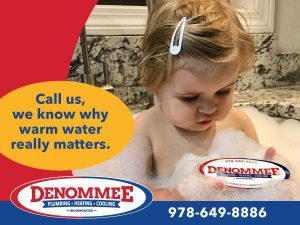 Denommee Plumbing, Heating & Cooling is your resource for all your water heater installation and service needs. We have the licensed experts and technicians, along with the right products, equipment and solutions to serve all your home’s hot water needs. We can help, whether you need repairs on your gas, electric, oil, indirect, tankless or tankless coil water heater. We service nearly all existing types and brands. Our service is legendary, and we have decades of experience in getting hot water heater systems installed and repaired clean, fast, professionally and at the right price.
Denommee Plumbing, Heating & Cooling is your resource for all your water heater installation and service needs. We have the licensed experts and technicians, along with the right products, equipment and solutions to serve all your home’s hot water needs. We can help, whether you need repairs on your gas, electric, oil, indirect, tankless or tankless coil water heater. We service nearly all existing types and brands. Our service is legendary, and we have decades of experience in getting hot water heater systems installed and repaired clean, fast, professionally and at the right price.
Experiencing water heater problems?
Give us a call with the existing brand name, model number, serial number, and a description of the problems you’re experiencing. We have the answers and solutions. Call the professionals at Denommee Plumbing, Heating & Cooling, your local water heater experts now at 978-649-8886 to schedule an appointment with our friendly, knowledgeable staff.
Hot water taking too long to reach your faucet (wasting water)?
While there can be many issues that cause this issue including a damaged water heater, clogged pipes, and old units, one of our solutions is a hot water recirculation pump.
Running out of hot water?
The most common answer to this issue is an improperly sized unit. When the water heater for your home is not properly sized it is common for you to quickly run out of hot water; usually when you need it the most! Let our experienced technicians properly size and install your homes water heater.
Water too hot (scalding)?
Causes of scalding water can include the unit’s thermostat being set to high or an electrical issue causing the thermostat to produce water that is too hot to use. Regular water heater maintenance from the Denommee Plumbing, Heating & Cooling can help ensure your water temperature will never be too high.
Sulfur smell?
When it comes to unpleasant sulfuric smells from your water heater, potential causes include:
- Option 1: Your first option is a cleaning. Pumping chemicals into your existing tank to kill any bacteria , then replacing your anode rod with a non-magnesium type.
- Option 2: You can replace the heater with a new one and start fresh by installing a non-magnesium anode or power anode rod.
- Option 3: This is your best solution! Our expert staff can install a new tank that does not require an anode for tank protection; such as the stainless steel water heater! We offer installation services with a lifetime warranty that will eliminate this problem for good.
Temperature fluctuations?
Examples of common problems that can lead to hot water fluctuations are:
- A faulty thermostat giving poor temperature readings.
- Faulty or degraded sacrificial anode in the water heater.
- A broken cold water dip tube.
- Or a faulty pressure relief valve.
Low hot water pressure?
Low hot water pressure is typically due to a clog in the system. These clogs are the result of sediment build-up and calcium deposits that form over time. Let our expert technicians provide your water heater with regular cleaning to ensure your system water pressure is optimal.
Requesting hot water heater service and book appointments is simple and easy, just visit here on our website.
Water Heater Buyers Guide
Choosing a water heater involves a lot of decisions. Read on for our buyer’s guide intended help you to organize all the important information and processes it.
Water Heater Fuel Types
 There are several different types of fuel for hot water heaters. The three most common are electricity, natural gas, solar, and liquid propane. Most people choose the fuel type that is compatible with their home’s existing infrastructure. If you don’t have natural gas running to your home, then you probably need to settle for electric.
There are several different types of fuel for hot water heaters. The three most common are electricity, natural gas, solar, and liquid propane. Most people choose the fuel type that is compatible with their home’s existing infrastructure. If you don’t have natural gas running to your home, then you probably need to settle for electric.
Natural gas seems to be the most ideal fuel in terms of convenience, efficiency, and cost. Less popular, but highly efficient, heat pump water heaters and geothermal water heaters are also available.
Additionally, indirect water heaters are storage tanks that use the primary boiler/furnace for heating fluid that circulates throughout a heat exchanger inside this storage tank. The energy stored via the water tank causes the boiler to minimize the switching from the off/on position; thereby, saving energy. The indirect water heaters are also used with high-efficiency boilers and soundly insulated tanks, which creates a less expensive way of delivering domestic hot water.
Tank Water Heater or Tankless?
Storage, or tank-type water heaters have a reservoir of hot water readily available. When you turn the tap to hot it takes that hot water directly out of the top of the tank. When water is taken out of the tank it is simultaneously replacing it at the bottom of the tank with cold water, ensuring that it is always full.
With an instant hot water heater, or tankless, the water passes through the unit where a heat exchanger does the work. This provides hot water instantaneously and constantly for as long as it is needed. This eliminates the need to store hot water in a tank to be reheated, as well as the standby heat loss that occurs when the heater is not being used.

If you are going electric, then this is sort of a toss-up decision. Electric isn’t the most efficient way to fuel tankless water heaters. You may just want to stick to a traditional tank water heater.
However, with natural gas installations, the technology is currently at a point where tankless is viewed as superior to tank, almost unanimously. You only heat the water you use, and though a more expensive purchase, tankless installations last quite a bit longer. You save in the long run and conserve energy. If you don’t think you will live in your home long, then it may not be worth the initial investment (although you can use the on-demand unit as a selling point).
What Size Water Heater Do I Need?
For tankless, what you need to know is that the flow rates of your faucets and appliances are an important factor. You just need to be able to do a little math. You’ll see BTU outputs listed prominently on new water heaters, but what you really need to know is how many gallons per minute (gpm) it can heat? If the unit can heat 8 gallons per minute, that means you can run hot water to at least five faucets that operate at 1.5 gpm. Tubs and showers operate at about 2 gallons per minute. If you have a large home, consider that it might be a good idea to get two smaller output tankless units, as opposed to one large one.
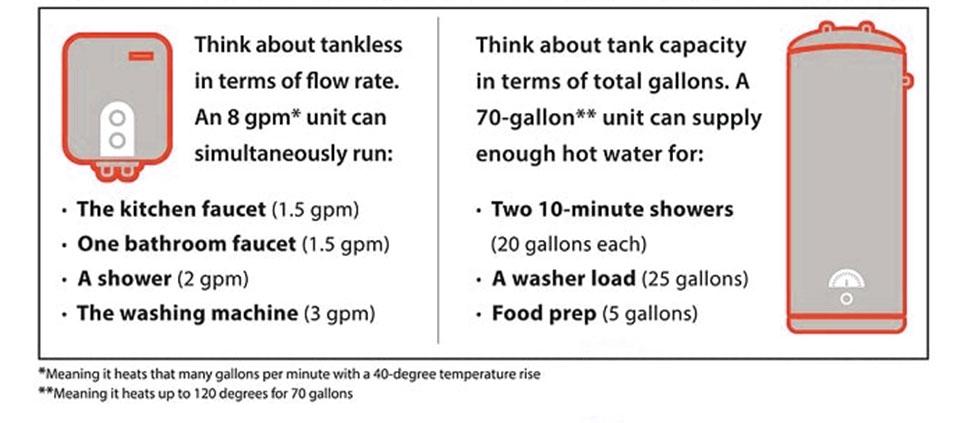
For storage installations, you need to make a calculation based on the capacity of the tank. A 10-minute shower uses up about 20 gallons of water. That means that a 55-gallon water heater tank is going to deliver hot water for up to three simultaneous showers. Factor in that you might be doing food prep and other chores, and it’s easy to see why big families choose 100-gallon tanks or opt to go with on-demand solutions. For crying out loud, you need 15-30 gallons just to wash a load of laundry (and that’s with newer, efficient washers). Another thing you need to consider is the first-hour rating, which indicates how much hot water you can produce in the first hour after usage.
How Long Do Water Heaters Last?
The answer really depends on the type and what kind of stress you put on it.
- Tank water heaters typically last 8-12 years.
-It’s not all that uncommon to make them last as many as 15 years, though - If you have a tankless water heater, you should expect it to last about two decades
Other Features & Considerations
- If you live in an area that has hard water issues, you may want to look for water heaters with anti-scale technology.
- Think about where the temperature & pressure (T&P) valve is located (top or side mount) and if that matters to your installation.
- What’s the warranty?
- Are the drain valves made of brass or plastic?
- Does the water heater have a digital display?
- Would a recirculation pump produce savings for you?
Replace or repair?
- If your gas or electric heater is more than 10 years old, it may be time to replace it rather than spending a lot of money fixing it. Most heaters last 6 to 12 years. You will find our replacement options to be a better value.
- Indirect water heaters, which heat water directly from your heating system, can have up to a 20-year warranty. Most are made of stainless steel and can last a long time. Replacing these is more costly, so makes good sense to repair them.
- With today’s high-efficiency units, such as tankless and power vented systems, you can expect some components to fail. Tankless heaters need annual or biannual maintenance, depending on water quality and usage.
Call the professionals at Denommee Plumbing, Heating & Cooling, your local water heater experts now at 978-649-8886 to schedule an appointment with our friendly, knowledgeable staff.
Tank Water Heaters
If you’re ready to upgrade or update your home’s hot water source, you may be surprised at how many options are available, but the most popular water heating system remains the storage tank water heater.
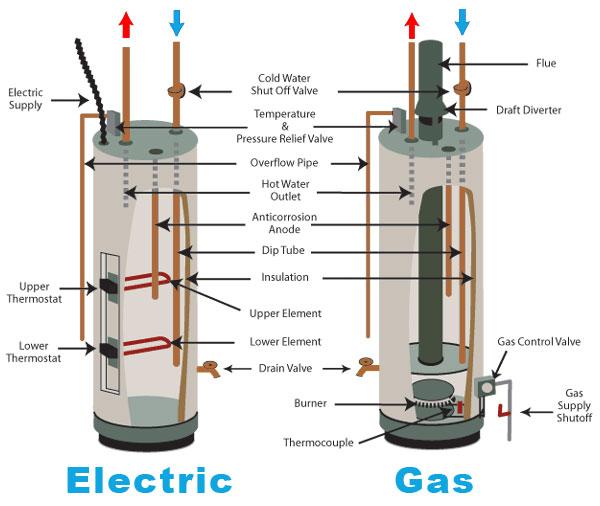
The biggest reasons for the enduring popularity of this style is a lower cost and it keeps anywhere from 20 to 80 gallons of hot water ready to go. As water from the storage tank is used, cold water enters at the bottom of the tank so that the tank is always full.
Storage tank water heaters can use electrical power, natural gas, propane, or other fuel sources. Electric water heaters use two heating elements, with one at the bottom and the other in the middle of the tank. Gas water heaters use burners and heat the tank, which then heats the water. Be sure the water heater you choose matches the fuel type available to you. While an electric water heater is usually much more efficient, its recovery rate (how fast it can keep up with hot water usage) is much slower than gas so gas water heaters usually make most sense for families and larger households.
While the storage tank means that you can have hot water soon after turning the tap, it does mean a tank will lose heat. According to energy.gov tankless, on-demand water heaters avoid this loss of energy, but storage tank water heaters can be insulated to minimize this loss. Technology to improve energy efficiency―and to reduce operating costs―is making gas storage tank water heaters attractive options for energy-minded consumers, particularly for those with natural gas service available. Energy Star qualified high-efficiency gas storage water heaters can save a family of four $25 per year or more in energy costs. It may not sound like much, but it adds up over time.
What Size water heater tank?
No matter the fuel used, you want to match your new water heater to your household needs. The “first hour” rating refers to the number of gallons the water heater can supply each hour when starting with a full tank of hot water. This rating is dependent on the size of the tank, heat source and the heating element size. Focus on the one hour a day when you and your family use hot water the most. Is it during the morning rush as everyone is getting ready for work and school? Or is it of an evening when chores have the dishwasher and clothes washer going at full speed?
It’s estimated that 10 gallons of hot water are used per shower (more for some), two gallons for shaving, four gallons for hand dishwashing and food prep, six gallons for an automatic dishwasher and seven gallons for a clothes washer.
The average U.S. family, with 2.54 people living at home, might have three showers in the morning (30 gallons), with one shave (2 gallons), and one small round of dishwashing for those morning cereal bowls (4 gallons). This would have a peak hour hot water demand of 36 gallons and would look for a hot water heater with an absolute minimum of that number.
Proper Installation is key
Proper installation is one of the keys to longevity for equipment that requires a significant monetary investment and is tasked with providing hot water daily without pause. In addition, gas water heaters, for example, require a gas supply, cold water supply and flue connection that may be beyond most do-it-yourselfer’s ability and comfort level.

Heated water expands and can lead to a build-up of pressure in your tank. The TV show “Mythbusters” demonstrated how dangerous this can be when they turned a home water heater into a rocket. In homes where the thermal expansion is blocked from the public water supply, expansion tanks and temperature and pressure relief valves (T&P valve) work to release built-up pressure.
Bradford White: The Professional’s Choice
When it comes to tank type hot water heaters, Bradford White brand is the clear choice for the professionals at Denommee Plumbing, Heating & Cooling. They are the only brand of tank-type water heater that we sell, install and warranty. For good reason.
 With a history of providing water heating solutions for over 130 years, Bradford White leads the industry as one of the most technologically advanced manufacturers of water heating, space heating, combination heating, and water storage products in the world. Proudly employing over 2,300 people at American facilities Bradford White’s goal is to deliver high quality, superior products made by American craftspeople.
With a history of providing water heating solutions for over 130 years, Bradford White leads the industry as one of the most technologically advanced manufacturers of water heating, space heating, combination heating, and water storage products in the world. Proudly employing over 2,300 people at American facilities Bradford White’s goal is to deliver high quality, superior products made by American craftspeople.
They are also the only major tank-type water heater manufacturer that is 100% committed to the professional installer. The company has built a stellar reputation among professionals for outstanding 24/7 service and for products that are unequaled in reliability, energy-efficiency, installation flexibility, and performance. Not available in big box retail stores.
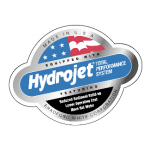



Exclusive features include the Bradford White ICON System® Intelligent Gas Control and ICON HD™ Commercial Control Systems, the Defender Safety System® with ScreenLok® flame arrestor technology, the Hydrojet® Total Performance System which reduces sediment buildup and thermal stratification, and the Vitraglas® tank lining for protection against corrosion.

The Bradford White Water Heater product offering is comprised of more than 8,000 models for nearly every residential, commercial, and industrial application. We are proud to be part of their preferred network of professional contractors.
Call Denommee Plumbing, Heating & Cooling, your local water heater experts now at 978-649-8886 to schedule an appointment with our friendly, knowledgeable staff. Requesting hot water heater service and book appointments is simple and easy, just visit here on our website.
Tankless Water Heaters
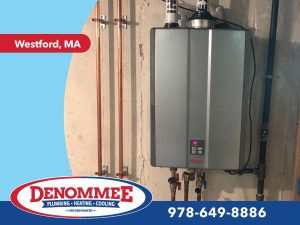 Traditionally, homeowners have installed tank water heaters, where stored water is heated. A tankless water heater is a solution that does not utilize a tank or stored water. It heats water only when needed, on-demand.
Traditionally, homeowners have installed tank water heaters, where stored water is heated. A tankless water heater is a solution that does not utilize a tank or stored water. It heats water only when needed, on-demand.
Maybe your traditional tank water heater is unable to keep up with your family’s hot water needs. Perhaps you’d like a more energy efficient solution. After all, water heating amounts to nearly 20% of a home’s energy costs. Or, like many of our customers, the choice to go tankless is because they value the freedom and convenience of having an endless supply of water for their home. At Denommee Plumbing, Heating & Cooling, we are your experts for tankless hot water heater installation and service. Despite the variations in fuel type, all tankless water heaters work in roughly the same manner. Keep in mind that most on-demand water heaters have about a 35-degree rise, meaning if you want 85-degree water, the source needs to be at least 50 degrees before passing through the water heater unit.
How Do Tankless Water Heaters Work?
For many homeowners, tankless water heaters, also referred to as on-demand water heaters, are a great option. Having a basic understanding of how they work and how they might save you money on utility bills, can help you decide if your home would be a good fit. Just how does a tankless water heater work? It’s a reasonably uncomplicated process, but the results are powerful.
The basics:
- Coldwater goes in.
- The water is heated by coils
- Hot water comes out.
These units use high-powered burners to heat your water on demand. The water quickly runs through the heat exchanger and comes out of your shower or faucet piping hot. The benefit is in the fact that you won’t be wasting energy on the standby heat loss that you experience with traditional water heaters. Regardless of what kind of fuel-type you install, you will want to calculate your flow rate to determine the specifications you require. So if you plan to run your dishwasher and shower all off the same heater, simultaneously, add their two flow rates together to get an idea.
Types of Tankless Water Heaters
- Natural Gas – probably the most common fuel type.
- Propane – keep in mind a lot of units can be modified with conversion kits. You can convert from natural gas to propane.
- Electric – initially not very cost-effective for most homeowners, but times are changing.
Things to Consider when Purchasing a Tankless Water Heater
Proper Installation
Rinnai recommends that the tankless water heater installation should be performed by a licensed contractor who is trained to handle the plumbing, gas, electrical and venting aspects of a tankless water heater and is aware of all local and national gas fuel codes. Having a non-licensed professional perform the installation can cause operational and performance issues. Denommee Plumbing, Heating & Cooling are fully licensed and insured to install and support all brands of tankless water heaters. Further, we are your local Rinnai ACE (Advanced Comfort Expert) partners.
Location of Installation
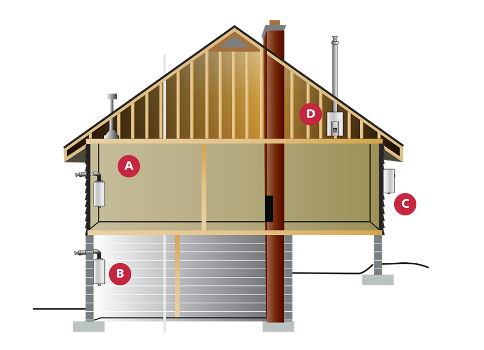 The clean, modern and space-saving design of Tankless Water Heaters gives you the flexibility to install on virtually any wall inside your home―not just in the utility room.
The clean, modern and space-saving design of Tankless Water Heaters gives you the flexibility to install on virtually any wall inside your home―not just in the utility room.
And to save even more space, you can even mount a Tankless Water Heater on the outside wall of your home.
A. Interior wall – bathroom or closet
B. Interior wall – basement
C. Exterior wall – near bathroom or kitchen
D. Attic
Venting
Depending on placement within the home, interior models of Tankless Water Heaters can vent vertically through the roof or horizontally through an exterior wall. Rinnai offers multiple venting options for the super high-efficiency models that offer optimum safety and performance.
Gas Line Sizes and Fuel Types
Tankless models are available for natural gas or liquid propane fuel types, which contributes to increased efficiency and lower carbon emissions. These units are designed to provide maximum performance and operating efficiency using either a 1/2″ or 3/4″ gas line.



Hot Water On-Demand
Say goodbye to waiting for hot water. Rinnai® tankless water heater technology gives you hot water in seconds, not minutes. Waiting for hot water is frustrating and wasteful. On a chilly day, it can take several minutes for hot water to travel from the hot water heater tank to your shower. As the seconds tick by, you can waste the equivalent of 24 16-ounce bottles of water every time you shower. That’s an average of 8,700 bottles of water per person, per year.
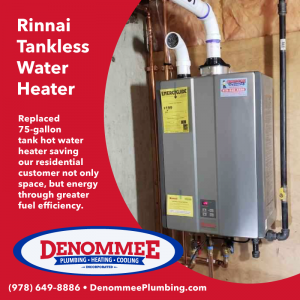 Instead, a Rinnai® tankless water heater with ThermaCirc360(™) technology recirculates hot water through your pipes, so as soon as you open the tap, you’ll get hot water within seconds, not minutes. It saves you time and money on your water bill.
Instead, a Rinnai® tankless water heater with ThermaCirc360(™) technology recirculates hot water through your pipes, so as soon as you open the tap, you’ll get hot water within seconds, not minutes. It saves you time and money on your water bill.
Are you ready to reduce energy with hot water on demand from the #1 selling tankless water heating brand in North America? Your family deserves nothing less.
Call Denommee Plumbing, Heating & Cooling, your tankless water heater experts now at 978-649-8886 to schedule an appointment with our friendly, knowledgeable staff.
Additionally, you can request hot water heater service and book appointments is simple and easy, just visit here on our website.
Case Study
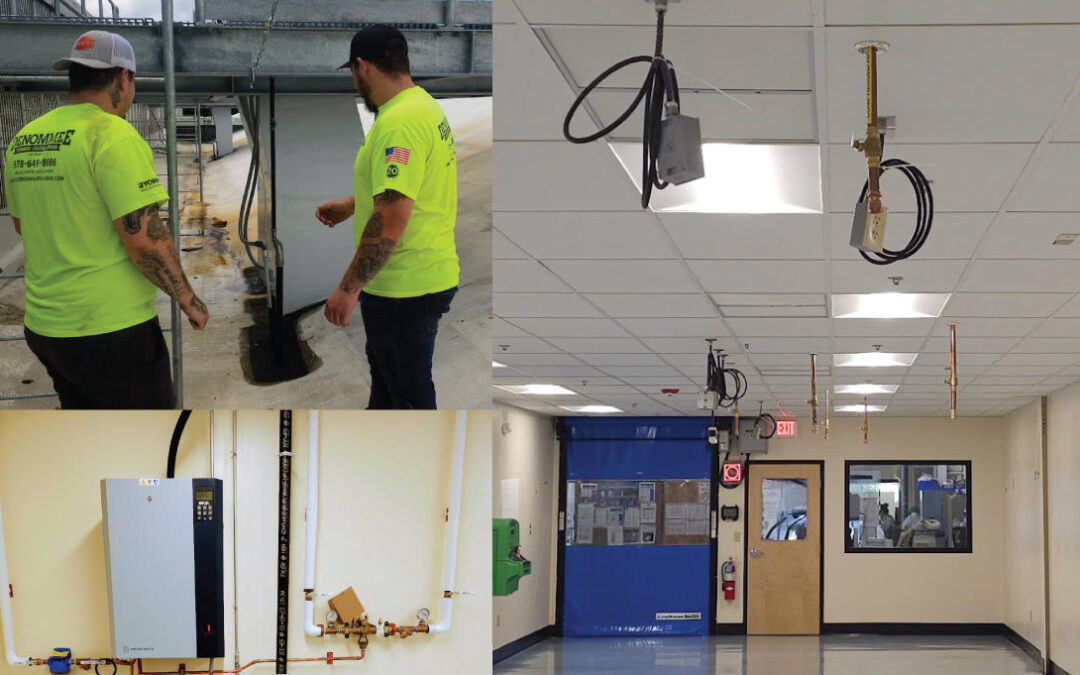
Commercial Plumbing for Lab Facilities
The Denommee commercial plumbing services team recently completed a comprehensive commercial plumbing scope for biomedical training and manufacturing lab facilities in Waltham, MA. The renovation work included running over 300 linear feet of 2” gas piping on the roof,...
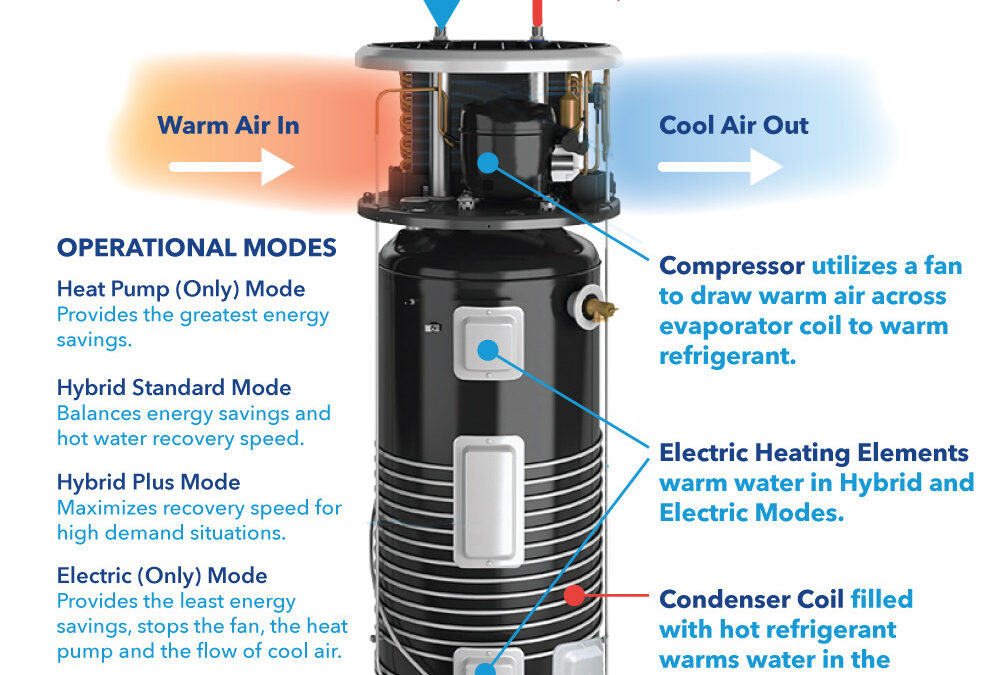
Heat Pump Water Heaters: How Do They Work?
Heat pump water heaters are three times more efficient than conventional electric water heaters and can lower operating costs by 50%. How are they able to do this? How do heat pump waters work? Read on to find out. At It’s easier to move something than to make...

Bath Plumbing Renovations, Repairs and Fixture Upgrades
When searching for bath plumbing or bathroom plumbing installation near me, or bath plumbing fixture repair and bath fixture upgrades near me, be sure to contact the Denommee Plumbing, Heating & Cooling team of bath plumbing experts. Count on our dedicated team of...

Commercial VRF HVAC Mechanical Installation
Ten tons of cooling fun. Our Commercial HVAC crew is busy installing two, ten ton high-efficiency VRF air conditioning systems for a new cafeteria space at Franklin Pierce University in Rindge, New Hampshire. The Denommee team of commercial HVAC installers, commercial...
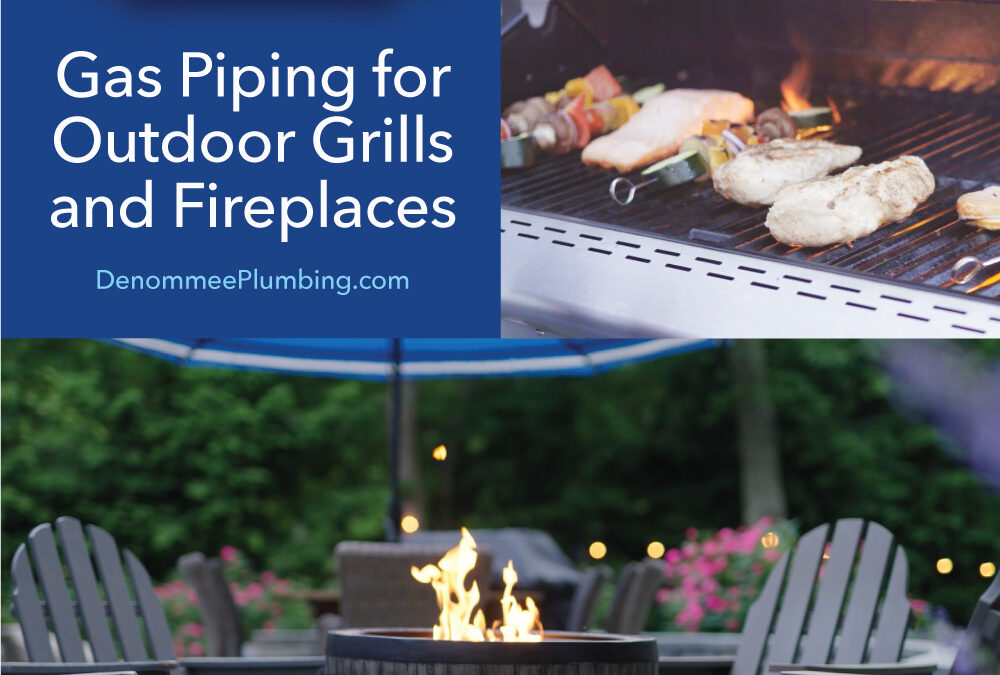
Gas Piping for Outdoor Firepits and Outdoor Grills
Count on our plumbing pros to safely keep your summer backyard fun flowing with properly sized, installed, and inspected gas piping for outdoor firepits and gas grills. Whether you are searching for gas pipe plumbers near me for natural gas pipe installation or...
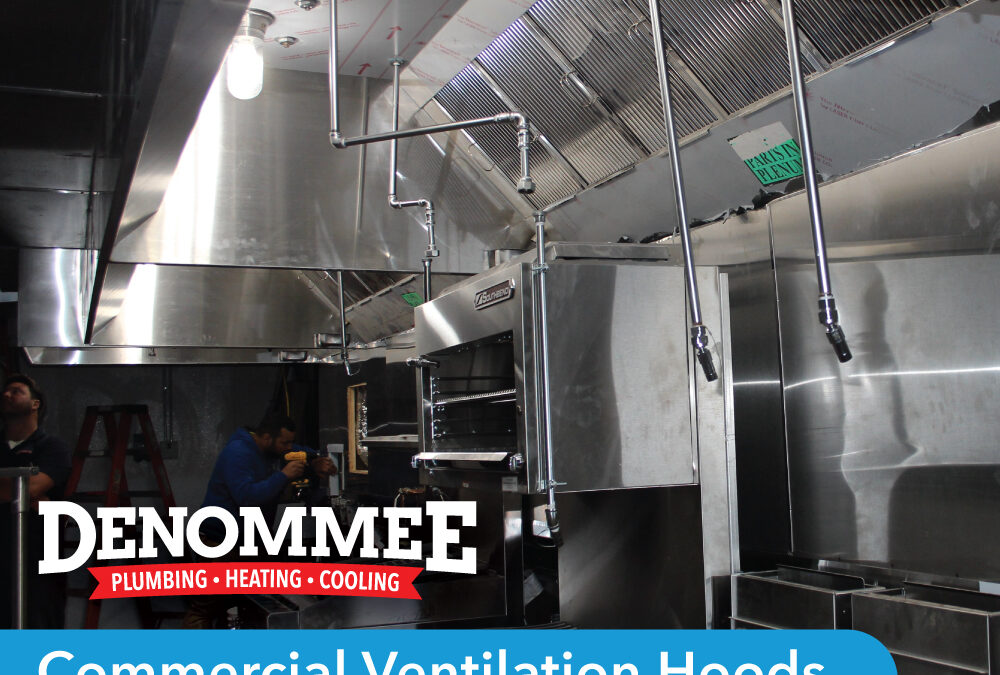
Commercial Ventilation Hood Installation and Replacement
Our commercial services team provides expert installation and replacement of commercial ventilation hoods for commercial kitchens. The Denommee crew of professional commercial HVAC estimators and commercial HVAC installers deliver complete kitchen ventilation system...

Happy Birthday to Kayla!
An integral member of our busy dispatch team, Kayla Leger deftly schedules plumbers and HVAC technicians and juggles a multitude of calls while amazingly maintaining a bright, positive attitude. Cheers and Happy Birthday Kayla, we are so lucky to have you on our crew....
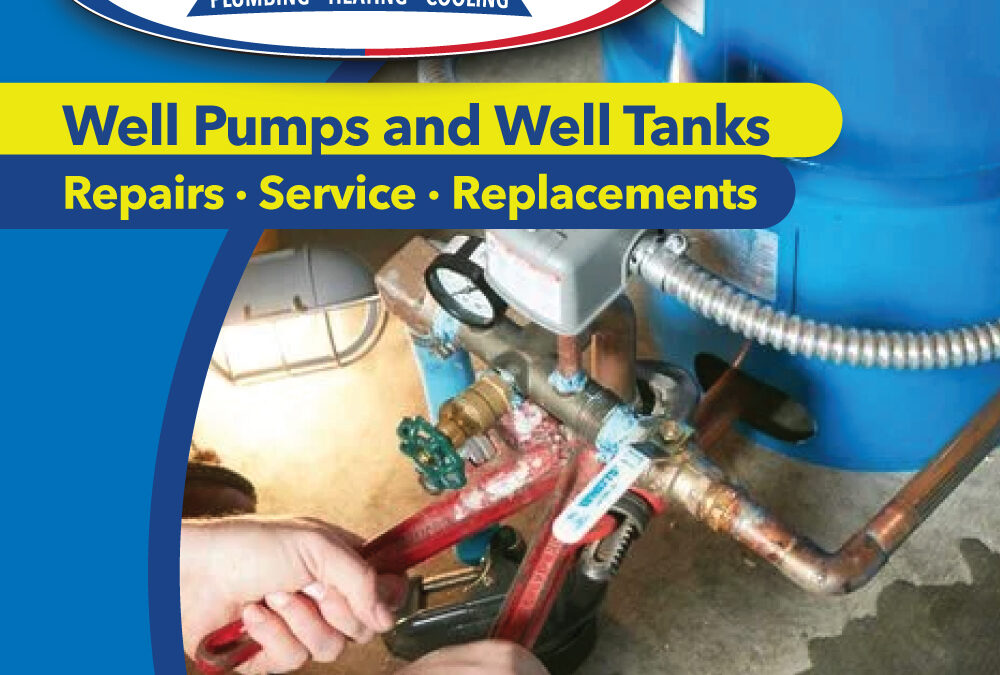
Well Pumps and Well Tank Plumbing Repairs, Service & Replacement
Denommee Plumbing, Heating & Cooling, Inc.'s plumbers are ready and able to ensure your well tank and well pump systems are operating in peak condition. Request well pump and well tank service quotes and well tank piping service by clicking here or visiting...
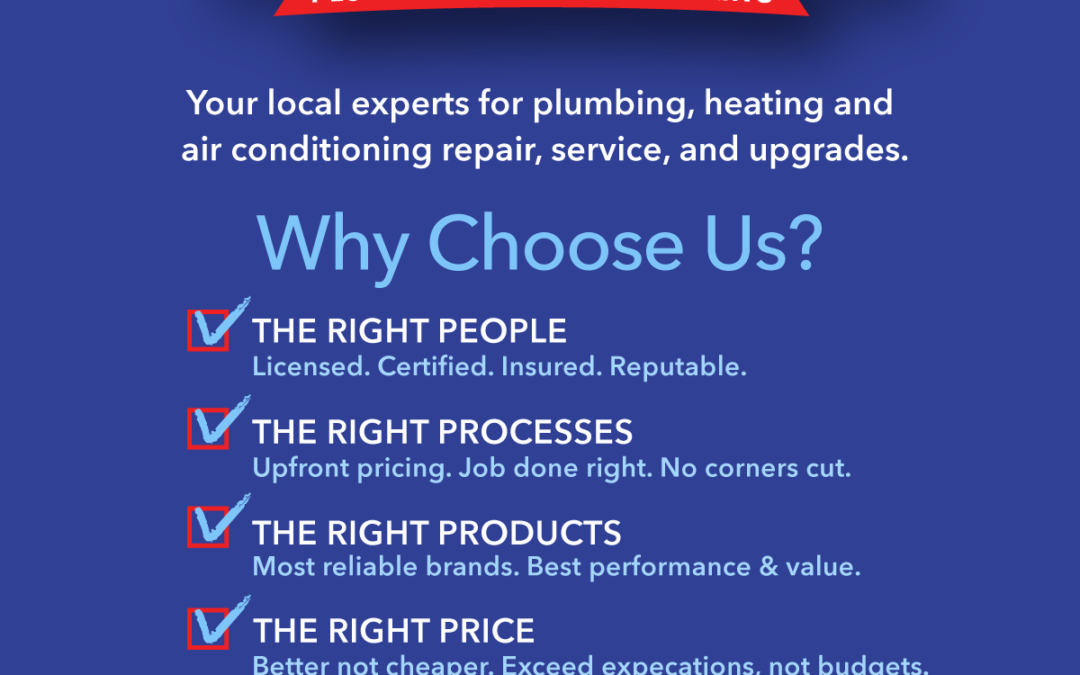
Why Choose Us? How Denommee Checks the Boxes
When it comes to making large investments in home improvement, who you select for a contractor is critical in helping ensure a successful—and satisfying—outcome. Here is how we check the boxes. THE RIGHT PEOPLE We are fully licensed in all of our trade offerings:...
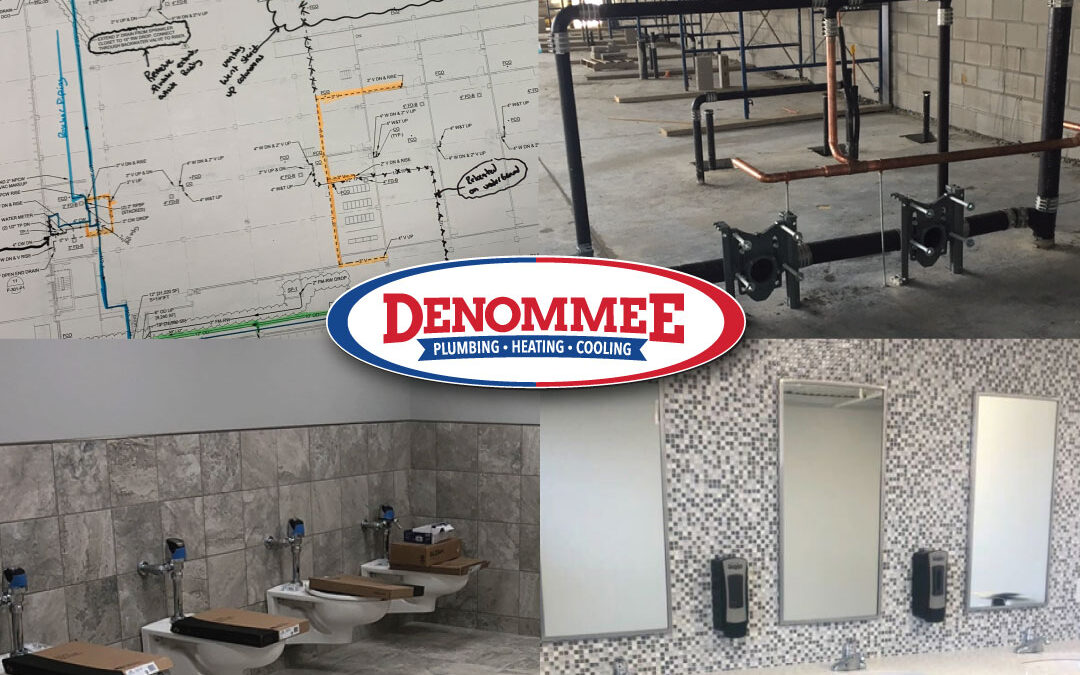
Commercial Plumbing From Plans to Final.
The Denommee commercial plumbing services team is headquarted in our Burlington shop is the local commercial plumbing, commercial mechanical, commercial hvac contractor serving the greater Burlington, MA and Greater Boston area. From reliable, accurate plumbing plan...




